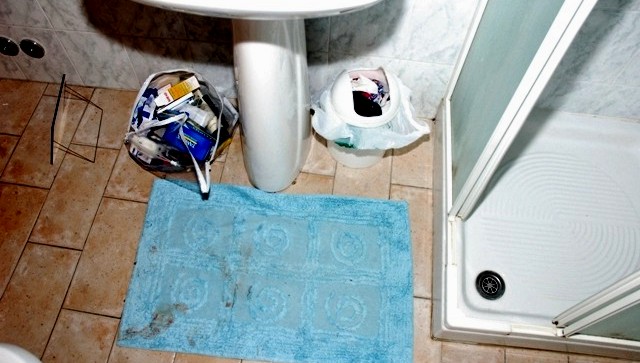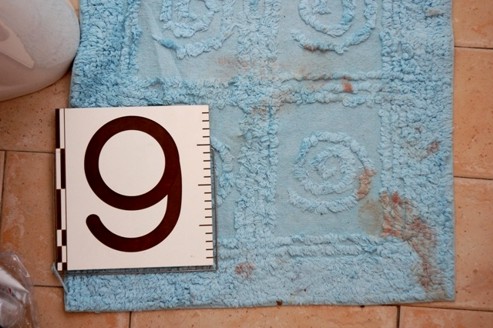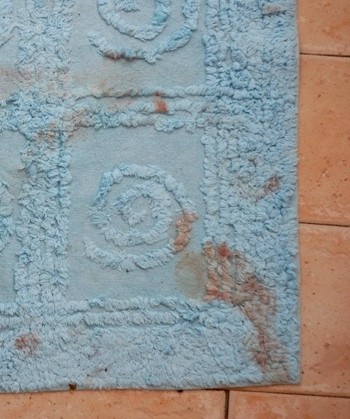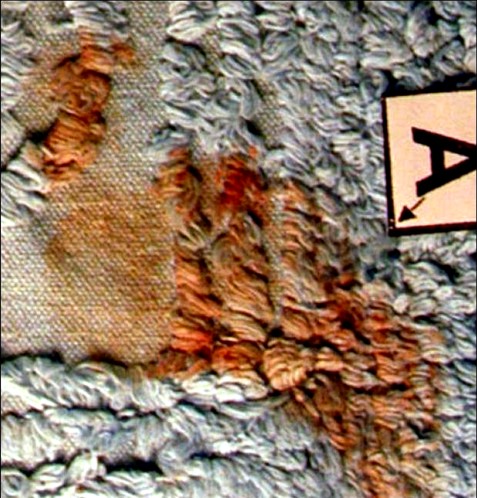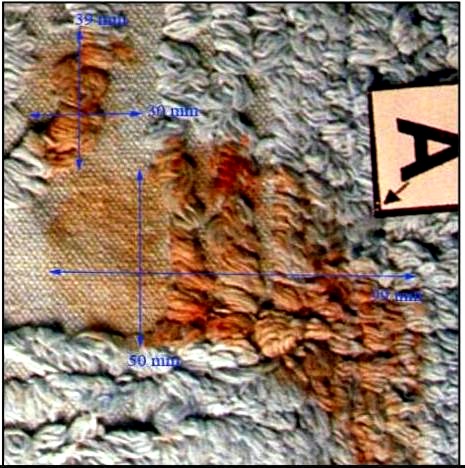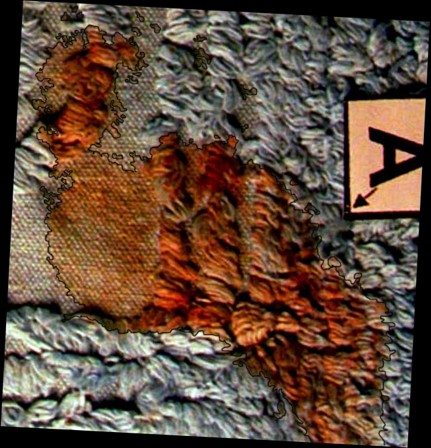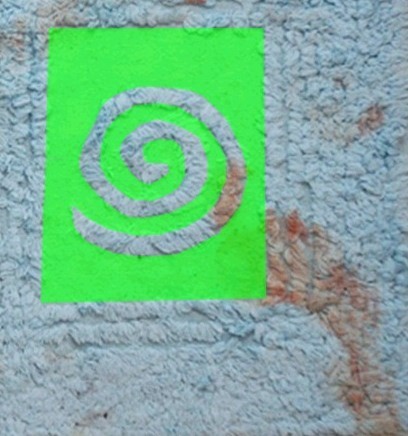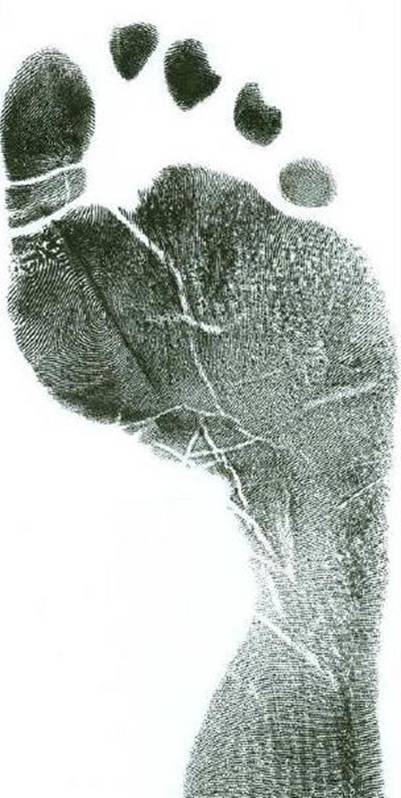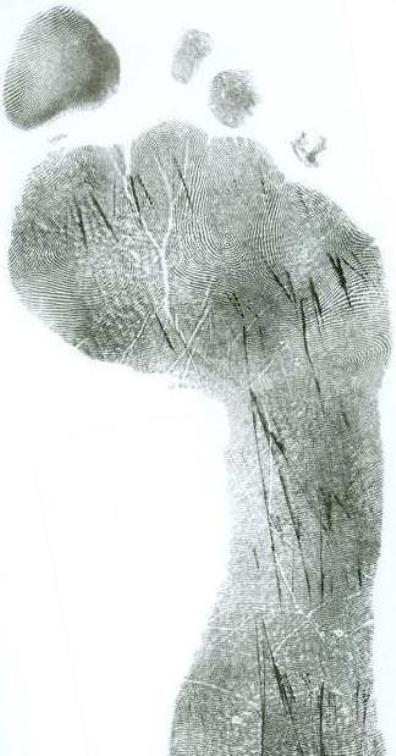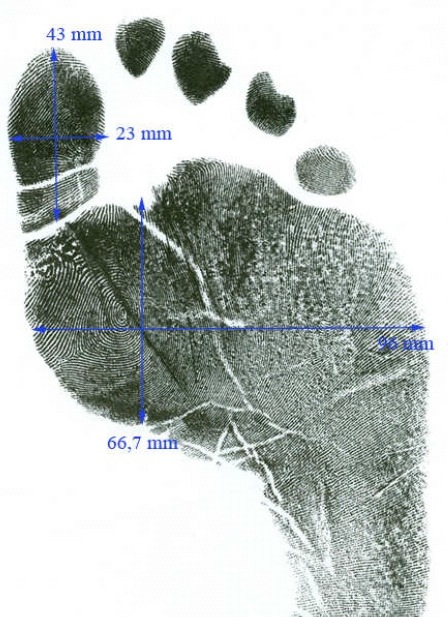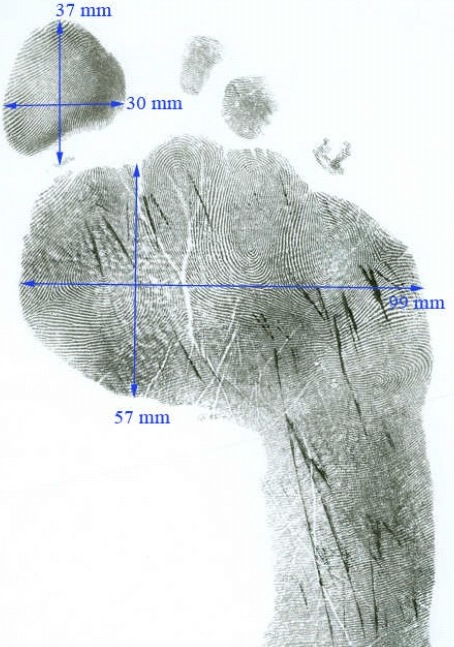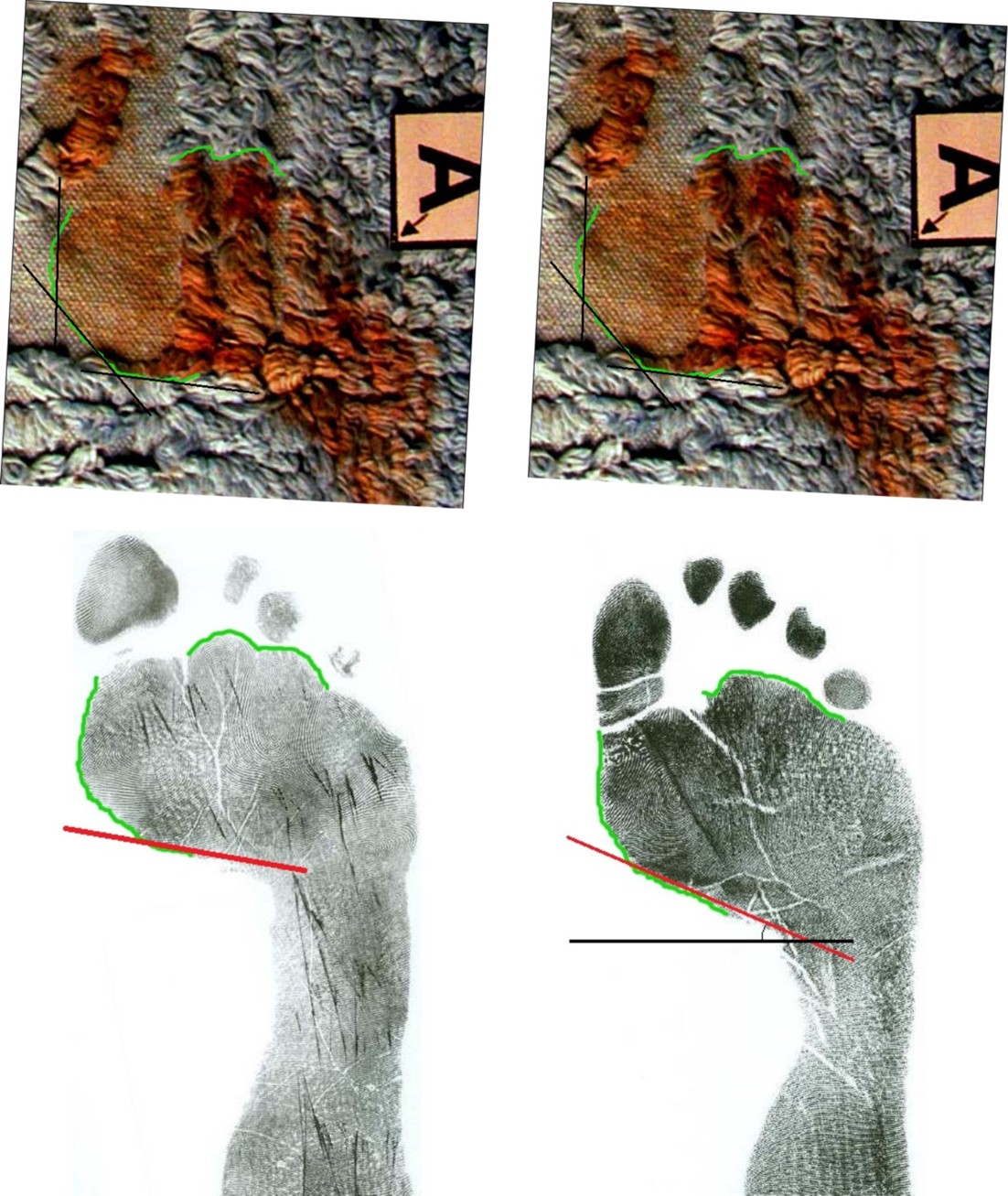
Headsup: The deep expose with associated comments below was first posted by Finn MacCool on 12/20/13. Knox's failed calunnia trial in 2009, failed 1st appeal in 2011, and failed final appeal in 2013 had come and gone. Some 500 zombie misrepresentations had recently reappeared in Knox's English-only 2013 book. See main support documents here and also (vitally) this and this and this.
Category: Real crimescene
Thursday, April 27, 2017
Multiple Attackers and the Compatibility of the Double DNA Knife (Exhibit 36)
Posted by James Raper
Our YouTube whiz DelPergola’s video of November 2010
Ed note: This evidence area is enormously compelling - but also emotionally difficult. It is why initially we did not publish our translation of the Micheli Report. And why a quarter of the trial was behind closed doors with the media excluded. That well-meaning decision has bedeviled the case ever since, because only the jury and others in court then - including the white-faced and tongue-tied accused pair - were exposed to the full power of the prosecution testimony.
Material from some of my previous posts on TJMK (link at bottom here) was incorporated into my Justice on Trial book. From Chapter 15, this is the second of several posts setting out further material.
Before looking at the forensic evidence, which is the final theme I identified earlier, it will be helpful to take into account the wounds suffered by Meredith, and whether these suggest anything as to the dynamics of the murder, and whether any of them were compatible with the knife recovered from Sollecito’s kitchen, Exhibit 36, called the Double DNA knife because the DNA of Meredith was found on the blade and the DNA of Knox on the handle.
As mentioned earlier the autopsy was carried out by Dr Lalli.
It was observed that there were no significant injuries to the chest, abdomen or lower limbs.
The significant elements in the examination were described as follows :
A fine pattern of petechiae on the internal eyelid conjunctive.
The presence of tiny areas of contusion at the level of the nose, localised around the nostrils and at the limen nasi [threshold of the nose].
Inside the mucous membranes of the lips, there were injuries compatible with a traumatic action localised in the inner surface of the lower lip and the inner surface of the upper lip, reaching up to the gum ridge.
Also found on the lower side of the jaw were some bruising injuries, and in the posterior region of the cheek as well, in proximity to the ear.
Three bruising injuries were present on the level of the lower edge of the right jaw with a roughly round shape. In the region under the jaw an area with a deep abrasion was observed, localised in the lower region of the middle part at the left of the jaw.
Once the neck had been cleaned it was possible to observe wounds that Dr Lalli attributed to the action of the point of a cutting instrument.
The main wound was located in the left lateral region of the neck. A knife would be compatible provided it had one cutting edge only which was not serrated. The wound was 8 cms in length and 8 cms deep. The width could not be measured because the edges had separated due to the elasticity of the tissues both in relation to the region and to the position of the head, which could have modified the width. The wound had a small “tail” at the posterior end. The wound penetrated into the interior structure of the neck in a slightly oblique direction, upwards and also to the right.
Underneath this large wound, another wound was visible, rather small and superficial, with not particularly clear edges, “becoming increasingly superficial until they disappeared”, in a reddish area of abrasions. The knife had penetrated both Meredith’s larynx and the cartilage of the epiglottis, and had broken her hyoid bone. A consequence of that damage is that Meredith would be unable to vocalise, let alone scream.
There was also a wound in the right lateral region of the neck, also attributed to a pointed cutting instrument. This was 4 cms deep and 1.5 cms wide (or long). It had not caused significant structural damage.
The presence of two relatively slight areas of bruising, with scarce colouring and barely noticeable, were detected in the region of the elbows.
On Meredith’s hands were small wounds showing a very slight defensive response. A small, very slight patch of colour was noticed on the “anterior inner surface of the left thigh”. Another bruise was noticed on the anterior surface, in the middle third of the right leg.
The results of the toxicological analyses revealed the absence of psychotropic drugs and a blood alcohol level of 0.43 grams per litre.
Tests of histological preparations of fragments of the organs taken during the autopsy were also performed. They revealed the presence of “pools of blood” in the lungs.
The cause of death was attributed to asphixiation and loss of blood, the former being caused by the latter.
There was nothing in the pathology which confirmed that Meredith had been raped, though we should recall that Guede’s DNA was found on the vaginal swab, though not of a spermatic nature. For Massei this was confirmation that she had been subjected to a sexual assault.
—————————————
There was argument in court as to whether Exhibit 36 was compatible with the main wound. There was no dispute amongst the experts that it could not have been responsible for the wound on the right. The knife had an overall length of 31 cms and the length of the blade from the point to the handle was 17.5 cms. The width of the blade, 4cms from the point, exceeded the width of the right hand wound. The wound on the right was more akin to a pocket knife, or perhaps a flick-knife.
I shall look at the arguments advanced by the defence as to why the knife would not be compatible in a moment, but before that there is a simple logical point as to incompatibility based on measurements.
A knife would only be incompatible if the length of the wound was greater than the length of the blade of the knife, or if the width of the wound was less than the width of the blade. Exhibit 36 was therefore a priori compatible.
On this basis I would also have to concede that a pocket or flick-knife is not a priori incompatible with the main wound, unless (though we would not know) the length of it”˜s blade did not exceed 8 cms.
It should however be recalled that the width of the left side wound was also 8 cms. That is over 5 times the width of the wound on the other side of the neck. The width of the blade on Exhibit 36, 8 cms from it’s tip - and being approximately 3.5 cms wide- was over twice the width of the blade on the “pocket knife”. This fact, and the robustness of the larger weapon, particularly with regard to the observed butchering at the base of the left-sided cut, makes Exhibit 36 a far more likely candidate, in my submission, than a “pocket knife”, and that’s without taking into account Meredith’s DNA on the blade.
We can also enter into a numbers game as regards the experts (8 of them) who opined on compatibility. Massei tells us that Dr Liviero concluded “definite compatibility”, Dr Lalli and Professors Bacci and Norelli “compatibility” whilst “non- incompatibility” came from the 3 GIP experts nominated at a preliminary hearing. The latter were Professors Aprile, Cingolani and Ronchi.
As far as I am concerned “non-incompatability” is not hard to understand. It simply means compatible.
Professors Introna, Torre, and Dr Patumi, for the defence, opined that Exhibit 36 could be ruled out. Their argument was twofold. First, the length of the blade was incompatible with the depth of the wound had the knife truly been used with homicidal intent. Indeed, if it had been thrust in up to the hilt then the point would have exited on the other side of the neck. Secondly, they said that the smaller wound or the abrasions beneath the main wound, mentioned earlier, were in fact caused by the hilt of a knife striking the surface of the neck. Obviously if that were so then the main wound was not caused by Exhibit 36.
Their argument does not consider, because we do not know, what may have been the actual dynamics of the knife strike. We cannot know what was the cause of the underlying wound or the reddish area of abrasions. As to that wound it may have been the result of the knife edge being run across the surface of the skin and the abrasions may have had a different cause in the prior struggle for which there is ample evidence. Hence their argument seems very weak.
We cannot leave the topic without considering that there may have been more than two knives involved. This possibility arises from the evidence of Professor Vinci, for the defence. He considered blood stains that were on the bed sheet in Meredith’s room. These stains very much resembled the outline of a knife, or knives, laid to rest on the bed sheet.
It was Professor Vinci’s contention that the bloody outlines (a dual outline from the same knife he said) was left by a knife with a blade 11.3 cms long, or a knife with a blade 9.6 cms long with a congruent blooded section of handle 1.7 cms long (9.6 + 1.7 = 11.3), and having a blade width of 1.3 to 1.4 cms.
Taking these measurements as read they may seem incompatible with a pocket knife (such as Sollecito had a proclivity to carry) and they certainly are as regards Exhibit 36. It follows, he argued, that one has to infer the presence of a third knife in any hypothesis and if a pocket knife and Exhibit 36 are already accounted for by Knox and Sollecito then a reasonable inference is that the third knife would have to be Guede’s. Professor Vinci’s blade is not incompatible a priori with either of the two wounds.
The problem, and without going into detail on the matter, is that Professor Vinci’s contention and measurements are somewhat speculative depending on what one thinks one sees in the stains. It is rather like reading tea leaves. One could just as well superimpose Exhibit 36 over the stains and conclude that it was responsible for them.
Massei only briefly commented about the bloody outlines on the bed sheet. He opined that the blood stains were certainly “suggestive” but insufficient to establish any clear outlines from which reliable measurements could be established. Clearly then he did not accord any reliability to Professor Vinci’s measurements.
—————————————————-
We can now turn to the issue of whether Meredith’s injuries tell us anything about whether her attacker was a “lone wolf” or not.
Massei believed that Meredith’s injuries lay at the heart of the matter. It seemed inconceivable to him that she would first be stabbed twice and that she would then be strangled. The amount of blood, being very slippery, would make maintaining pressure on her throat difficult. So Meredith was forcibly restrained and throttled first. The hypothesis of a single attacker requires that he continually modify his actions, first by exercising a strong restraining pressure on her, producing significant bruising, and then for some reason switching to life threatening actions with a knife, thereby changing the very nature of the attack from that of subjugation to that of intimidation with a deadly weapon, and finally to extreme violence, striking with the knife to one side of the neck and then to the other side of the neck.
Massei described the first knife blow, landing on the right side of her neck, as being halted by the jawbone, preventing it from going any deeper than the 4 cms penetration. The court considered that this was an action to force Meredith to submit to actions against her will. The same hypothesis could also, of course, in view of the injuries to the jaw, apply as to the lack of penetration with Exhibit 36 on the other side
What surprised Massei about Meredith’s wounds was that in spite of all the changes in approach during the attack she somehow remained in the same vulnerable position, leaving her neck exposed to attack.
Massei paid particular attention to the paucity and lack of what can be regarded as defensive wounds on her hands by comparison with the number, distribution and diversity of the impressive wounds to her face and neck. He found this disproportion to be significant, particularly with regard to what was known about Meredith’s physicality and personality.
Meredith was slim and strong, possessing a physicality that would have allowed her to move around with agility. She liked sports, and practiced boxing and karate. In fact she had a medium belt in karate. She would, had she been able to, have fought with all her strength. How then would a single attacker have been able to change hands with a knife to strike to both sides of her neck, let alone switch from one knife to another? He would have had to release his grip on the victim to do that, unless she had wriggled free and changed position, in which case he would have to subdue her all over again, but this time, if not before, she would be ready.
Since the attack was also sexual in nature, at least initially, how could a single attacker have removed the clothes she was wearing (a sweater, jeans, knickers and shoes) and inflicted the sexual violence revealed by the vaginal swab, without, again releasing his grip? It might be suggested, as the defence did, that Meredith was already undressed when the attack began, but for this to be the case one of three possible alternative hypotheses has to be accepted.
The first is that Guede was already in the flat, uninvited, and un-noticed by Meredith, which can only mean that the break -in was genuine but un-noticed by her. The second is that Guede was there by invitation and that their relationship had proceeded by agreement to the contemplation of sexual intercourse when Meredith suddenly changed her mind, unleashing a violent reaction from Guede. The third is that, having been invited in Meredith then thought that he had left, although he had not.
Having looked at the staging we can surely rule out the first hypothesis. As to the second, it does not fit with what is known about Meredith’s personality and the relationship she had been developing with Giacomo. As to the third it is difficult to imagine that in a small flat Meredith would not have checked before securing the front door and preparing for bed.
Massei found it was highly unlikely that one person could have caused all the resulting bruises and wounds by doing the above, including cutting off and bending the hooks on the bra clasp. The actions on the bra clasp alone would necessitate someone standing behind her and using a knife to cut the straps, requiring the attention of both hands from her attacker, during which time Meredith would have had the opportunity to apply some self-defence. It has to be conceded though that this could have happened when she was concussed, though there is no persuasive physical evidence of a concussive blow, or during or after she had been mortally wounded.
Massei concluded that there was little evidence of defensive manoeuvers on Meredith’s part, which to him meant that several attackers were present, each with a distribution of tasks and roles: either holding her and preventing her from making any significant defensive reaction, or actually performing the violent actions. He concluded that the rest of the body of evidence, both circumstantial and forensic, came in full support of such a scenario. He concluded that two separate knives had been used and that one was from Sollecito”˜s bedsit.
Although, at the trial, the defence had attempted to explain a scenario whereby a single attacker might have been responsible for the injuries, that there had been multiple attackers was not a scenario with which any court, other than the first appeal court presided over by Hellmann, demurred.
Wednesday, June 17, 2015
Major Additions To Meredith Kercher Case Wiki To Provide Complete Impartial Overview in English
Posted by azoza
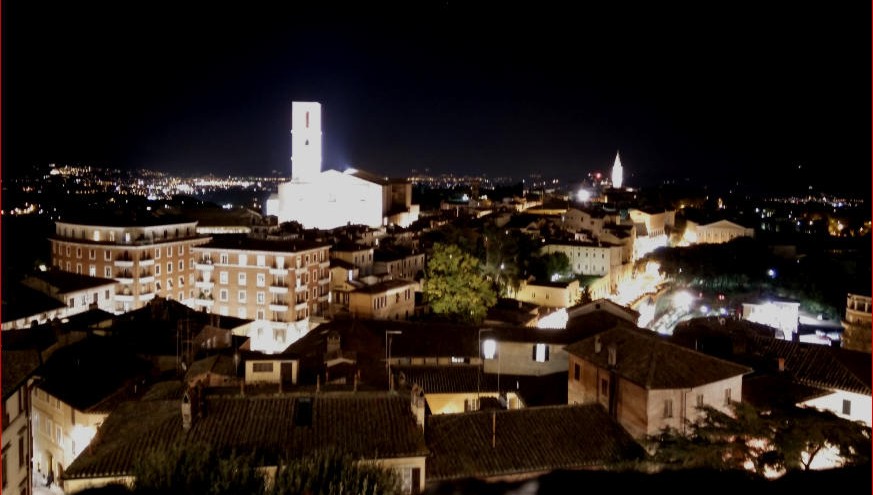
Image is of the very beautiful Perugia at night
Origin and mission
The impartial Murder of Meredith Kercher Wiki began in 2013.
The seed was people discussing how to overcome the flawed Wikipedia article of the case. That article relied on sources like Candace Dempsey, Nina Burleigh and American media. In other words, biased or incomplete sources.
In May 2013, Edward McCall set up the website, with the help of volunteer editors from the Perugia Murder File community. Its mission statement was:
Were Amanda Knox, Raffaele Sollecito, and Rudy Guede responsible for the death of Meredith Kercher? This wiki style site was created by a group of volunteer editors to inform the public about the case, by providing translations of original documents and evidence presented at trial.
This continues to be the aim of the Wiki: to make available documents and translate them properly. Our interest is not selectively posting documents, like the Knox campaign has done. We want to make all the facts available, without bias or selecting. We believe all the facts support the notion that all three defendants are responsible for Meredith Kercher’s murder.
Purpose of this post
The purpose of the article here is to let people know of recent changes to the website.
The Wiki is revised when new documents and translations continue to be received. Existing webpages are tweaked when time allows. Webpages are sometimes changed so information can be better presented. Or the website structure is changed when a significant page is introduced.
For example, a new page listing a lot of evidence was added in November 2014. This page can be directly accessed from the main page. That evidence list page has links to other sections of the website, like “˜wikified’ testimony, for easier reference. More links will be added and more evidence noted as more documents become available.
Major redesigns
The website had two major redesigns earlier this year. The main page was redesigned to provide clearer “˜at a glance’ updates. We did this primarily to keep everyone up-to-date with the March 2015 Cassazione decision. The boxes on the main page also note updates to other parts of the website. Also, we added buttons so any webpage on the site can be shared on various social media.
The other major redesign has been the addition of the “˜file library’.
Completing the picture
For those long familiar with the case, source material had been seriously lacking. There have been large gaps. The Knox campaign has posted some documents, but their “˜collection’ has always been incomplete. As examples:
1) The crime scene photos start at “˜dsc016’. What about photos 1 through 15?
2) No photos of Sollecito’s place, Guede’s place, via Sperandio or elsewhere
3) They posted many Massei transcripts, but not all. They never posted the 2nd day of Knox’s testimony, or the days when the Kercher family and consultants testified.
4) Some Massei transcripts they posted had pages missing.
5) They have posted many defense consultant reports, but few prosecution consultant reports.
6) They only posted a few Hellmann transcripts, but not all.
7) They only posted one Micheli transcript, but not the others.
8) Hardly any depositions.
9) A lot of police reports are still missing.
In the past six months, we have been trying to correct this. We have set up a file library, which will be the repository of as many case-related files as can be gotten. Files will ultimately include documents, photos, videos and audio- whatever is part of the public record of this tragic case. The files are made available as links for downloading. Eventually many will also be “˜wikified’ so anyone can do a word search through the documents. And when time allows, key documents will be translated.
There are thousands of files related to this case - too many to put on one page. A single file page would take forever to scroll and would be terribly confusing. So the library is structured into subsections. The basic idea is “˜nested boxes’. Once you select a section, you “˜drill down’ through pages to get to document links. Then you click “˜back up’ to the higher levels so you can move to other sections.
Some pages have a mixture of links to documents and links to subpages. These will eventually be simplified for clarity.
Not all file library pages have been created. More pages will be required as more files come in. Once the document files (PDFs) portion is nearly complete, pages will be reviewed and the library layout will be tweaked. At that point, when we’re comfortable with all the pages and their names, links will be added to allow browsing across sections or in sequential order. This hasn’t been done yet to avoid redoing a lot of work later.
A directory tree is a strong possibility too.
The seven sections
The library has over 900 PDFs and photos scattered across 7 major sections.
The 1st section
This section Context and people is empty for now. It will have photos of Perugia, the cottage, nearby locales and pictures of the people involved in the case. We are sifting through photos and erasing duplicates. Once that’s done, this section will quickly fill out.
The 2nd section
This section 2007 Investigations has files related to police investigations in 2007, the arrest and crime scene photos and videos. As mentioned, not all crime scene photos and videos have been made public. We hope to gather as complete a collection as possible. Of course, anything showing Meredith Kercher’s body will be censored, in line with the wishes of the Kercher family, and to maintain dignity. In the past 1.5 months, we’ve gotten over 80 depositions of witnesses and other documents related to early investigations. Things like preliminary police reports and police correspondence. Here you can also find phone and prison taps.
The 3rd section
This section Arrest trials has filed related to the cautionary arrest trials. This includes the Matteini court, the Ricciarelli court and the 2008 Cassazione court, presided by judges Gemelli & Gironi. Files include court hearing transcripts, motivation reports and other files pertinent to these hearings. This is missing quite a bit still, but we hope to correct that.
The 4th section
This section 2008 Investigations has files related to police investigations in 2008. While the murder was discovered on Nov 2, 2007, and arrests were made that month, the actual police investigation continued until the following year, finishing in June 2008. Files here include additional phone and prison taps, police reports from Rome and Perugia, additional depositions and other related documents.
The 5th section
This section Statements and writings contains writings and depositions of the three defendants. GKS = “Guede Knox Sollecito”.
The 6th section
This section Trials and Appeals and Reports is the largest section. We may revise or split this section further. Currently it contains all documents related to the main trials. All three defendants took part in the first main trial, the 2008 Micheli court. Micheli indicted Guede and found enough evidence against Knox and Sollecito. After the Micheli court, Guede’s trial path separated from the other two because he chose a fast-track option. So there are 3 subsections: Micheli, Guede trials and Knox + Sollecito trials. The Knox + Sollecito trials page has further subpages for the Massei court, the Hellmann appeals court, the Nencini appeals court. In this section, one can find court transcripts and reports, correspondence or depositions introduced during court proceedings. So a lot of files.
The 7th section
This section is extra material.This will contain documents, photos and videos indirectly related to the case. Things like interviews, documents on forensics, lab manuals, crime scene analyses, documentaries, related trials like the police calumnia trials, etc.
A few quick notes:
1. There are many versions of the Massei motivations report on the Internet. Most are missing two pages. Another version comes in four parts. We edited ours so this is a complete version with the “˜famous’ missing pages.
2. Similarly with the Borsini-Belardi motivation report. Many versions out there, most of them improperly OCR’ed, with sections missing. Our version is a scan version, not the OCRed one.
3. As noted before, recent additions include a lot of depositions of witnesses taken in the first week of police investigation. You can find these in the “2007 police work” page.
4. Police summaries of the crime scene surveys, and fingerprint reports, are at the bottom of that same page.
5. There’s a PDF containing a “˜5 volume’ police photo report. This PDF has photos of Via Sperandio currently not in the crime scene photos. But certainly those photos are part of the same Nov. 2007 crime scene photo survey. Anyway, you can find it in the Crime Scene page at the bottom. It’s called Photo-photographic-file-censored. We edited out pictures of the body, to preserve dignity of the victim.
6. Towards the bottom of the “2008 investigations” page, we recently added two police charts, and the first “shoeprint report” by Rinaldi & Boemia, which has more data on shoeprints. Their second report concentrated on the footprints.
7. We have the Cassazione March 2015 dispositivo. We will be posting that along with other documents shortly.
In conclusion
The file library is an ongoing thing. We hope to make real progress here, so everyone can look at all the facts of the case, not just a few picks. A bright light is needed on as much material as is possible to offer, in honor of Meredith Kercher, the victim.
When we post a new file batch, we add an update note on the Wiki home page.
The Meredith Kercher Wiki is committed to being the essential record of all publicly available documents and testimonies about the case, to benefit the general public and the media. Please circulate this widely, and check in regularly. There are more changes to come.
ADDED 12 JULY
On 2007 Investigations: Police work page
2007-11-03-Log-cellphone-KercherM-English.pdf
2007-11-03-Log-cellphone-Sollecito.pdf
2007-11-07-Log-landphone-Sollecito.pdf
2007-11-27-Police-deposition-Capezzali.pdf
On 2007 Investigations: Arrests page
2007-11-07-Prosecutor-notice-Request-to-validate-Arrest-Knox-Lumumba-Sollecito.pdf
On Arrest trials page
2008-01-21-Testimony-Bernaschi-Sollecito.pdf
2008-05-15-Motivazioni-Matteini-reconfirming-cautionary-arrest-Knox.pdf
On Arrest trials: KSL: Matteini trial page
2007-11-08-Testimony-Matteini-Knox.pdf
On Arrest trials: KS: Ricciarelli trial page
2007-11-30-Motivazioni-Ricciarelli-Arresto-Appello-Knox-Sollecito.pdf (forever missing Ricciarelli report)
On 2008 Investigations page
2008-11-08-Deposition-Monacchia.pdf
On Trials: Micheli court page
2008-09-16-Testimony-Summary-and-Rulings-Micheli.pdf (first Micheli hearing)
2008-10-27-Report-Fioravanti-Vodaphone.pdf
On Trials: KS: Massei and Cristiani trial page
2009-11-20-Closing-arguments-Mignini.pdf (forever missing)
2009-11-21-Closing-arguments-Comodi-Knox.pdf (forever missing- Comodi describes 3D reconstruction)
On Trials: KS: Hellmann and Zanetti trial page
2010-12-11-Testimony-Lawyers-Knox-Parisi-Maori-Ghirga-Vedova.pdf (missing Hellmann hearings)
2010-12-18-Testimony-Costagliola-Comodi-Perna.pdf
2011-01-22-Testimony-Lawyers.pdf
2011-03-12-Testimony-Mandarino-Pucciarini-Ciasullo-Bevilacqua-IniG-IniR.pdf
2011-03-26-Testimony-Brughini-Curatolo-Lucarelli.pdf
2011-05-21-Testimony-Napoleoni-Conti-Vecchiotti-Knox.pdf
2010-12-11-Court-doc-Zanetti-case-review.pdf
On Trials: KS: Nencini and Cicerchia trial page
2014-01-20-Testimony-Maori-Crini-Pacelli-Fabiani-Perna-Maresca-Donati-Colotti.pdf (missing Nencini hearing)
On Trials: Knox and Sollecito trials page
2015-03-30-Sentenza-Cassazione-Dispositivo-Knox-Sollecito.pdf (sentence, not motivations report)
Friday, May 29, 2015
Those Pesky Certainties Cassation’s Fifth Chamber May Or May Not Convincingly Contend With #4
Posted by Cardiol MD
1. SERIES OVERVIEW
This post continues a response to the March 27th, 2015 announcement of Cassation’s Fifth Chamber that it had decided that Amanda Knox and Raffaele Sollecito were Not Guilty of the November 2007 Murder in Perugia of Meredith Kercher.
The Fifth Chamber’s Reporting Judge Antonio Paolo Bruno, was reported to have said that the trials had “not many certainties beyond the girl’s death and one definitely convicted”.
In fact Judge Bruno was wrong.
Post #1 and Post #2 and Post #3 reported dozens of Certainties contained in “the trials”.
As previously noted, the Existence, Timings, Durations, and General-Locations of all the telephone calls are a very fertile source of Certains, or Certainly-Nots. This is because civil telephone time-keeping all over the Earth’s surface, including in Italy, the U.S. and the U.K, use, and specifically did use in November 2007’s Perugia, the Coordinated Universal Time Protocol (CUT).
Coordinated time-keeping assures that the time assigned to a telephone event is accurate and very precise, independent of where it occurs. It’s almost as if these November, 2007’s Perugia “˜phone users were wearing criminal-offender’s ankle bracelets. CUT records enable decisive challenge to the credibility of a false witness (impeachment).
(Uncoordinated Time-keeping could have resulted in wrong times being assigned to a telephone event)
2. MORE SUCH CERTAINTIES
(A) SOLLECITO’S PHONE
43. IT IS CERTAIN THAT SOLLECITO’S PHONE WAS EITHER AFFIRMATIVELY SWITCHED-ON, OR HAD-BEEN-MOVED, AT 6:02:59 AM, 2 NOVEMBER 2007
Therefore, contrary to the Defense “reasoning”, cited below, there is Certain proof that Sollecito’s phone was switched on or had been moved at 6:02:59 am on 2 November 2007, and that Sollecito &/or Knox were awake at that time, contrary to their assertions, which are Certainly false:
Nencini Page 158:
“If in fact one can agree with the Defense reasoning by which there is no certain proof that at 6:02:59 am on 2 November 2007 Raffaele Sollecito’s phone was switched on (by himself or by Amanda Marie Knox, the only two present in the apartment) allowing [142] reception of the SMS sent to him by his father a good six hours earlier, the only logical alternative is that someone obviously moved the phone inside the apartment from the location in which it was positioned, and where it was not receiving the “signal”, to a different location in the apartment, where the “signal” was received.What matters, and what the Court finds proved, is that at 6:02:59 am on 2 November 2007 in the apartment at 130 Via Garibaldi, they were not in fact asleep, as the defendants claim, but rather the occupants were well awake, so much as to switch on or move the phones.”
More in this case:
(B) WITNESS ANTONIO CURATOLO
Antonio Curatolo had testified at the Massei Trial that he had seen Amanda Marie Knox and Raffaele Sollecito, from 9:30pm to around midnight of 1 November 2007 in Piazza Grimana”
However, the Hellmann Court of Appeal’s motivazione had rejected the reliability of Curatolo’s Testimony.
The SCC Panel, Annulling the Hellmann Court of Appeal’s motivazione had, in turn rejected and annulled Hellman’s Analysis of Curatolo’s Testimony, stating on pp 67-69:
“The Hellmann Court of Appeal rejected the reliability of the testimony of Antonio Curatolo which, in the reconstruction of the First Instance Court, had been taken as a basis of proof that the negative alibi offered by the two accused was false, and which constituted one of the tesserae of the mosaic which led to their being held to have been present at the scene of the crime. Incidentally, it is worth recalling that the First Instance Court held, via reasoning that was correct from both a legal and logical point of view, that the false alibi must be considered as evidence against [the accused], to be placed in relation to the other elements of proof in the context of the entire body of evidence.
This method of analysing the testimony, as observed by the Prosecutor General submitting the appeal, is absolutely subject to censure in that it displays a lack of the prerequisite thorough examination of the facts and circumstances, so that the conclusion that was reached [by the Hellman Court of Appeal] ““ that in indicating the two accused students as having been present in Piazza Grimana, he confused the evening of 31 October and the evening of 1 November ““ clashes with ascertained facts that seriously contradict such an absolutely certain assumption, so as to shed full light on the well”foundedness of the charge that the justifying discourse is contradictory and thus manifestly lacking in logic (it was in fact proven by other facts that on the evening of 31 October that neither Knox nor Sollecito, who were both occupied, the former at Lumumba’s pub where she was preparing for the normal activity associated with the Halloween festival, the latter at a graduation party, could have been present in Piazza Grimana at around 11 PM).
The assertion that the sighting of the two young people by the witness should be shifted to 31 October (page 50 of the sentencing report) because the context described was more suitable to that day than the next day, since [the latter] did precede the arrival of the Scientific Police but [50] [was] taken out of context, is a manifestly illogical assertion, not only because it contradicts facts which unequivocally demonstrate that the two were not in the piazza on the evening of 31 October (a fact of fundamental importance in the context of the evaluations) and thus the impossibility of squaring the circle in the sense proposed, but also because it follows an utterly weak inferential rule.
Starting from the need to undo the knot of contradiction presented by the testimony (he saw the two young people the evening before the investigation of the Scientific Police and he saw them in the context of the Halloween festival), the Hellmann Court of Appeal, after having heard the witness testify a second time and after having verified that he erroneously placed Halloween on the night of 1”2 November, they heard the witness reiterate that his temporal placement of the fact was anchored to the described presence of people who were all dressed in white and that, after midday on the day after he saw the two young people, he caught sight of the men in white in via della Pergola (a fact with a very high level of certainty, more than any other) together with the police: this notwithstanding, the Court reached the conclusion that his testimony could not be accepted due to the man’s deteriorating intellectual faculties and due to his lifestyle, since he was a detainee for drug dealing when he testified the second time and was a habitual heroin user.
Once again, the progression of the argument emerges as obviously illogical, in that the evaluation of the testimony should have been correlated (regardless of the conclusions, this being a discussion of evaluation methods) to the unique objective fact of absolute reliability (the presence of individuals wearing the white suits, the day after the sighting of the two in the piazza, at a time earlier than 11 PM”midnight) because that is a fact whose existence is certain, which was a unique identifying circumstance, which could not but remain imprinted on the mind more than any other; while instead, once again, character issues were considered and asserted, furthermore, without any scientific examination that could ascertain whether the man’s intellectual faculties had deteriorated. Moreover, Curatolo showed up when called upon to testify, in both the first and second instance trials and, even well after the fact, he never had any difficulty recognizing the two accused as those whom he had seen in Piazza Grimana the evening before he noticed the men dressed in white (whom he called “extra”terrestrials”) and the police in via della Pergola.The fact that he had been a homeless man who spent all day in the piazza was not a reason for dismissing him as an unreliable witness out of hand, at the cost of colliding with the accepted principles on the matter of the reliability of testimony. In conclusion, [51] a contribution [that was] expressed with certainty and noted in the trial transcripts of the witness, and again during his second testimony (“as certain as I’m sitting here” he said of having seen the two accused the evening before the day in which he saw the men in white suits and the police), cannot be circumvented by merely referring to the character of the author of the contribution; this would have required a process of evaluation through facts with equally strong probative evidence.
Moreover, the opinion must be annulled and remanded, since the explanations of the reliability of the witness Curatolo are incomplete (as they did not take into consideration the facts that contradicted the conclusion reached by the Court), vitiated by an incorrect application of the laws governing the matter. The “˜precise and serious’ nature of the evidence provided by the testimony was dismissed in the [Appeal] opinion without testing its concordance with other evidence, on the basis of a conjecture (that the witness superimposed the evening of 31 October onto that of 1 November) that was not even confronted with the facts contradicting its conclusions”
In summary, this SCC Panel ruled that Hellmann’s Motivazione “must be annulled and remanded” because it ignored facts contradicting Hellmann’s conclusion, and incorrectly applied “the laws governing the matter”, “without testing its concordance with other evidence”, not even confronting Curatolo “with the facts contradicting (Hellmann’s) conclusions”.
Therefore:
44. IT IS CERTAIN THAT CURATOLO WAS PRESENT IN PIAZZA GRIMANA ON THE EVENING OF NOV. 1st, 2007
45. IT IS CERTAIN THAT CURATOLO TESTIFIED THAT HE SAW MEN IN WHITE SUITS, AND POLICE PRESENT IN PIAZZA GRIMANA ON THE MORNING AFTER HIS SIGHTING OF AMANDA KNOX AND RAFFAELE SOLLECITO IN PIAZZA GRIMANI.
3. AND MORE BEYOND REASONABLE DOUBTS
(A) WITNESS ANTONIO CURATOLO
The SCC Chamber’s reasons, given above, for Annulling And Remanding Hellmann’s conclusions re Curatelo’s misremembering the Date, in spite of his specifically remembering that it was the evening before he saw the Official Commotions relating to Meredith’s murder, justify the Conclusion that:
8. IT IS BEYOND REASONABLE DOUBT THAT CURATOLO SAW AMANDA KNOX AND RAFFAELE SOLLECITO IN PIAZZA GRIMANA ON THE EVENING OF NOV.1st, 2007 ON MULTIPLE OCCASIONS. A FEW YARDS FROM THE COTTAGE AT NO. 7, VIA DELLA PERGOLA, WHERE, IN THE SAME SPAN OF TIME, THE MURDER TOOK PLACE.
WITNESS MARCO QUINTAVALLE
Nencini p 156:
“Amanda Marie Knox went to Marco Quintavalle’s Conad shop around 7:45am on 2 November 2007, obviously in search of something to buy that she could not find. She was noticed by Mr. Quintavalle who, at the trial, identified her with certainty in the courtroom. So we are able to affirm that Amanda Marie Knox was lying when she claimed to have slept at Mr. Sollecito’s house in his company until 10am in the morning on 2 November 2007.
Having already been proven false by witness testimony, the alibi given by the accused is also proven false by comparing it with objective data, which tallies with the witness testimony referred to above.”
SCC. Annulling H/Z p 50
“In this case, [the Defence argues that] a re”evaluation of the witness is not allowed, given that his testimony was correctly examined by the Hellmann Court of Appeal, knowing the lapse of time after which he offered his contribution to investigators. The witness’s statements were, for the rest, compared with those of his co”workers, who referred to the doubts expressed by Quintavalle on the exactitude of his identification. There is therefore no lack of logic in the reasoning, since the lack of logic must be manifestly perceived, whereas minimal inconsistencies must have no influence”
SCC ANNULLING H/Z p 70-71
“In reality, the notice taken of the witness’s statements, as pointed out by the Prosecutor General, is absolutely biased, since the sighting out of the corner of the eye referred to the girl’s exit from the shop, whereas the witness specified having seen her at a close distance (between 70”80 centimetres), adding that she remained imprinted on his mind “because of her very light blue eyes”, her “extremely pale face”, and “a very tired expression”.
Moreover, the witness clarified in his testimony that he became convinced that the girl who appeared in the newspapers was the one he saw in the early morning of 2 November 2007, given that the colour of her eyes could not be ascertained from the photo, but that he became certain once that he saw the girl in the courtroom. The selection made from the pool of information was absolutely one”sided, which distorted the evidence to the point of making it appear uncertain, whereas the witness explained the reasons for his perplexity and the development of his conviction in terms of certainty.
As noted by the Prosecutor General in the appeal documents filed, this portion of the report assumed relevance within the framework of the reconstruction and required an explanation based on an examination of the entire testimony; instead, through a process of unacceptable selection, only some of the testimony was considered to be of value, indeed, only that portion considered to be consistent with a [specific] conclusion, one that in fact required rigorous demonstration.
The result, once again, is blatantly and manifestly illogical. What is at issue is not a re”evaluation of the evidence ““ which is obviously prohibited by this Court, as the Defence for the accused has justly pointed out ““ but rather the need to point out a glaringly evident flaw that consists of an intolerable chasm between what is stated by the witness and what is acknowledged in the justifying arguments, on a point of significant importance, since it concerns the foundation of the alibi.
On this point also, the new judgment will have to be conducted in light of the preceding observations.”
Given the above:
9. IT IS BEYOND REASONABLE DOUBT THAT MARCO QUINTAVALLE SAW AMANDA KNOX IN HIS CONAD SHOP AT AROUND 7:45 am ON 2 NOVEMBER 2007.
Amanda Marie Knox was lying when she claimed to have slept at Mr. Sollecito’s house in his company until 10am in the morning on 2 November 2007.
To be continued, though we may need to wait until the end of June 2015 when SCC’s Motivazione is due.
Thursday, April 30, 2015
Those Pesky Certainties Cassation’s Fifth Chamber May Or May Not Convincingly Contend With #2
Posted by Cardiol MD
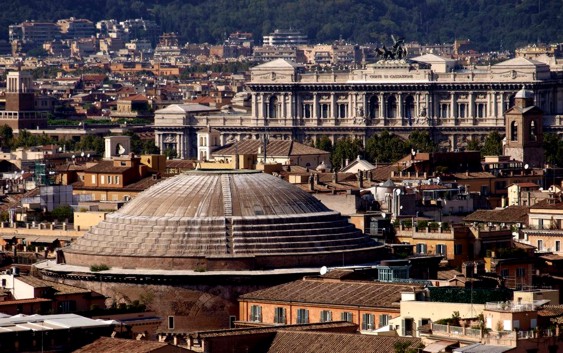
The Italian Supreme Court is in the background
1. This Series’ Ominous Context
On Friday, 27th March, 2015 a Panel of five Court of Cassation judges of the Fifth Criminal Chamber of the Supreme Court in Rome, found Amanda Knox, and Raffaelle Sollecito, Not Guilty of the Murder of Meredith Kercher.
The President Judge of the Fifth Criminal Chamber of this Supreme Court Panel is Gennaro Marasca, The Prosecutor General is Mario Pinelli, and the Reporting Judge for the Meredith Panel is Antonio Paolo Bruno.
Near the start of the above SCC hearings Judge Bruno was quoted as having said that the trials had “not many certainties beyond the girl’s death and one definitely convicted.”
We consider that to be flat-out wrong. Absurd in fact, as the hapless Hellmann & Zanetti could testify. So do numerous professionals well-briefed on the case in Italy. We expect soon articles in Italian similar to this one.
In fact if the forthcoming Marasca Sentencing Report attempts to brush the numerous real factual certainties under the table there is a near-certainty that the perverse verdict can be overturned by way of a lawsuit or a petition to the President of the Italian Republic.
Post #1 of 10 April described some 26 of the factual headaches facing the SCC under the strict Italian Legal Requirements for classification of Evidence as Circumstantial-Evidence.
The fact that the trials actually had very many certainties was demonstrated in Post #1, and continues in this Post.
2. Note On Circumstantial Evidence
Defendants typically trivialize Circumstantial-Evidence as “Only Circumstantial-Evidence”.
Actually, Circumstantial-Evidence is often the most potent evidence leading Finders-of-Fact to their Verdict. This is even more true in Italian Law because its Circumstantial-Evidence classification-requirement provides that an evidentiary circumstance or fact must be true to the level of being a Certainty. Therefore, for example, the unverifiable RS/AK broken water-pipe story can not be classified as Circumstantial Evidence and cannot legally be admitted as Evidence at all.
Continuing the review of the Massei Motivazione, the Nencini Motivazione, and the several past SCC rulings, demonstrating the large number of Certainties:
3. Certainties 27 To 30
27. THE SIMULATED BURGLARY
:
This Subject has already been commented-upon in Pesky #1, under the Heading “13. Crimescene Meddling?”:
“Having accomplished the Phone-Dump, Meredith’s killers next re-model the crime-scene, minimising the evidences of their identities, cleaning-up the evidences that it was “˜an inside job’, and simulating the appearances that it was “˜an outside job’.”
According to the Massei Summary, Part 3:
“8. The staged break-in
The Massei Report examined the evidence surrounding the broken window and disarray in Filomena Romanelli’s bedroom in order to determine whether a real break-in had occurred or the appearance of one had been staged….....
The court concluded that the disorder in Romanelli’s room and the breaking of the window pane constituted an artificial representation created in order to misdirect the investigations towards a person who, not having the key to the front door, was supposed to have entered through the previously broken window and then effected the violent acts on Meredith which caused her death.”
So Massei, having carefully analysed all the Evidence, and the Arguments on both sides Concluded that there was No Burglary at all, and that Meredith’s killers had deliberately created the appearance of a Burglary, in order to misdirect the Investigators of Meredith’s death.
According to the Hellmann-Annulling SCC Panel wrt the Simulated Burglary:
Page 56:
“The compartmentalisation of the single pieces of evidence thus weakened their value and their depth, since a piecemeal evaluation of their relationship and of the required synthesis inevitably followed, ignoring the increase in value that the pieces of the mosaic of circumstantial evidence assume when synergistically evaluated.”
The Panel begins its justification for Annulling Hellmann/Zanetti.
The Hellmann-Annulling SCC Panel Page 66:
“.....the simulation of the burglary should have been evaluated in light of the investigative data collected immediately after the event, such as Rudy’s shoeprints (along the path of his flight) and the traces of the victim’s blood detected in many spots in the bathroom used by Ms Knox and [49] Ms Kercher, surely carried there by third parties present in the house after the murder.”
The Panel takes-for-granted that the “Burglary” was Simulated by the Perps, and focuses on its improper evaluation by H/Z.
The Hellmann-Annulling SCC Panel Page 82-83:
“The Hellmann Court of Appeal preferred ““ in full agreement with the defence pleadings ““ to favour the information the unreliable Rudy Guede had conveyed in his chat with his friend Benedetti, i.e., that he was in via della Pergola around 9.00/9.30 PM on the first of November 2007; this information was correlated with the victim’s telephone records which registered:
a) an unanswered call at 8.56 PM
b) the dialling of the number 901, corresponding to an answering service at 9.58 PM, immediately after which the call was blocked
c) at 10.00 PM the dialling of the first number in the list of phone numbers for the Abbey bank, without however the dialling of the required dialling code
d) at 10.13 PM a GRPS connection of the length of nine seconds, most probably linkedto a multimedia message, without the necessity of human interaction.On the basis of these facts, the Hellmann Court reached the conclusion that Miss Kercher had not called her family again in the period of time between 8.56 and 11.00 PM, since shortly after the first attempt an unexpected event may have occurred, such as for example the attack, and the dialling of the number at 10.00 PM could have been done [61] by another person, who was not familiar with that mobile phone, while attempting to silence it, a fact which would place the time of death at before 10.13 PM.
The reconstructive path is permeated with factual deductions deriving from a series of conjectures and baseless suppositions, without any reliable, demonstrative basis, in spite of [other] findings of significant value which conflict with those [deductions] and have a greater probative value, which were reduced in their importance on the basis of an unsatisfactory reasoning, which stands out because multiple passages contradict other passages of the statement of reasons, and because of manifest illogicality which must be rightfully censured in this venue. “
The Panel implicitly includes H/Z’s failure to recognize the “Burglary"as simulated, as part of its “unsatisfactory” and improperly “baseless” reasoning.
NENCINI Page 175:
“In the cottage at 7 Via Della Pergola, on the day of 2 November 2007, in the early hours of the day and up until approximately 12.00 pm, nobody had a shower, just as no burglar had gottenin through the window of Filomena Romanelli’s room; more simply the totality of the circumstantial evidence examined to this point gives us a plain picture of how the defendants put into action a clean-up of the traces of the murder committed and activity to “derail” the investigations that involved a series of actions, a number of which are still to be described.”
So, having stated at length “the totality of the circumstantial evidence examined” Nencini concludes, that the defendants (Knox and Sollecito) had faked the “Burglary” and,
Nencini Page 335:
“...we exclude, for the reasons already expressed, that the murder was committed by a burglar caught in the act of entering the flat after breaking Filomena Romanelli’s window…”
The Nencini Appellate Court Judges, presumably recognise that their conclusion Knox and Sollecito had faked a burglary didnot implicitly exclude the co-existence of a real burglar.
So now they explicitly “exclude” the conclusion that the murder was committed by any burglar.
What will the Marasca Panel make of that?
28: THE SCREAM
Amanda Knox is herself the very first person to refer to the Scream, in her voluntarily insistent Written-Note of November 6th, 2007.
This allegation is generally accepted to be so factually Certain that its factual existence has never been plausibly disputed.
Massei Pages 98-99:
“.....it can thus be held that, in fact, towards 23:30 pm on November 1, 2007 there was a loud, long scream from a woman which came from [91] the house at 7 Via della Pergola.
After this scream, Nara Capezzali heard running on the metal stairs located below her residence in the S. Antonio car park towards the section used as the exit for the cars, and straight afterwards she heard running on the path situated in front of the house in Via della Pergola.The harrowing scream heard a little before must have caused a strong agitation in Mrs. Capezzali, who was rendered particularly sensitive and attentive to what might happen and who knows the area; therefore, it is to be held that she referred to noises on the metal steps and on the path because there actually were such noises and she was able to hear them.
Furthermore, the deposition of the witness Dramis, who referred to “šrunning steps”› heard about 23:30 pm on that same November 1st in Via del Melo, which is very close, almost a continuation of the path of the houseIp in Via della Pergola, could constitute some confirmation of this.
The running on the path in front of the house at 7 Via della Pergola shortly after the heart-rending scream leads this Court to hold that the heart-rending scream came from the house at 7 Via della Pergola; likewise, whoever’s running steps were heard on the metal steps and whoever’s running steps were heard a little later on the gravel path and leaves in front of the house at 7 Via della Pergola lead the Court to hold that more than one person came out of that house.”
So Massei “held” as a specific “fact” that the scream, came from the 7 Via Della Pergola cottage, rented by Meredith Kercher and Amanda Knox, among others, at about 23:30 pm on November 1st, 2007.
However, Hellmann/Zanettii, and the miscellaneous FOA systematically trivialized the Scream, e.g.: the Police made AK invent it; the Police suggested it to AK; the Police tricked AK into writing it down; there are so many Screams-in-the-Perugia-Night that the scream the Witnesses testified to having heard was not Meredith’s Scream; the scream the Witnesses testified to having heard was at some other time; and Meredith’s Scream was at yet another time. So-many imagined doubts were marshaled that Hellmann/Zanettii argued that there was too much Reasonable Doubt.
The Hellmann-Annulling SCC Panel Page 86:
“Before concordant pieces of data convergent towards a time necessarily later than the one established by the court, back to which the heart”rending scream of the unfortunate Meredith needs to be tracked, the appeals court preferred to draw the threads from Guede’s presentation of facts, [which he] delivered in a context outside the court, and anyway absolutely false (given that the accused declared himself to be uninvolved in the murder).
The conclusions drawn appear even more jarring if one only considers that the heart”rending scream was mentioned even by Amanda herself in her handwritten letter when the fact was not yet in the public domain. Not only this, but the reconstruction made by the Hellmann Court of Appeal is not even in line with the relevant post-mortem findings, which indicated a time of death range from 6.50 PM to 4.50 AM on 2 November, thus at a time around 11.00 to 11.30 PM according to the calculated average, so as the First Instance Court had argued, with greater adherence to the available evidence.
Thus, the statement of reasons suffers from a grave lack of logic and from inconsistency with other available evidence also on this point, openly showing an obvious explanatory inadequacy to which the judge of remand will have to bring remedy.”
So this SCC Panel Excoriates Hellmann/Zanetti’s biased and illogical reasoning wrt the scream, constructively ordering the judge of remand “to bring remedy”.
NENCINI stated on pages 117-118:
“.....from her very first statements, Amanda Marie Knox provides the picture that, at some point during the attack, Meredith was screaming. Indeed, it was only because of the poor girl’s scream [102] that the defendant imagined “what might have happened”. This scream, so excruciating that it caused her to move her hands to her ears to block it out, is introduced in the written statement on the same morning at the offices of the Perugia police. Significantly, this is the scream that was clearly heard by the witnesses Nara Capezzali and Antonella Monacchia. It was so “excruciating” that Nara Capezzali was beside herself, something that she told the First Instance Court hearing on 27 March 2009, having previously only spoken about it to the police, about a year after that night of November 2007.”
Thus does “the judge of remand” bring remedy, expressing no doubt that the scream Knox claims to have imagined “might have happened”, Certainly Did-Happen.
It will be interesting to see Bruno’s take if his SCC Panel submits its Motivazione.
29. THE KNIFE COLLECTED IN SOLLECITO’‘S FLAT
This Knife was mentioned in Post #1, in which the use of at least 2 knives in Meredith’s murder was established.
Massei Page 194:
“Seven samples were taken from the exhibit [reperto] acquired by the Flying Squad of Perugia (i.e, Exhibit [reperto] 36) and consisting of a large knife, 31 centimetres long; on the handle, from the trace indicated as “štrace A”›, the genetic profile of Amanda Knox was found and in a point on the blade, the genetic profile of the victim was found. All of the other samples gave negative results. “
Here, calling this knife Exhibit 36, Massei reports that Meredith’s DNA was found on this knife (In spite of the fact, corroborated by Knox herself, that Meredith had never been in Sollecito’s flat), as well as Knox’s DNA.
Massei Page 264:
“EXHIBIT 36 (THE DOUBLE-DNA KNIFE)
[282] On November 6, 2007, during the search carried out in the apartment in Perugia where Raffaele Sollecito lived, the 31cm-long knife was found.”
Here, Massei refers-back to when and where this knife was found.
Massei Pages 373-375:
“Of Raffaele Sollecito’s habit of carrying a pocket knife, Corrado De Candia also made reference, recalling that the blade of Raffaele Sollecito’s pocket knife had a length around 6-7cm and a width of 1cm or less.
In relation to the preceding (Raffaele Sollecito actively present at the scene of the murder, finding himself behind Meredith, pulling on the bra with violence, finally deciding to cut it), it must be affirmed that Raffaele Sollecito not only found himself at the scene of the murder and pursuing, with violence, the same objective as RudyGuede, but he is there with a well-sharpened knife (dangerous and thus capable of cutting a resistant material, such as that of a bra, [401] especially in the part that was cut, which may be seen in photos 117 and 119 in the second volume of photographic evidence) and having a blade probably around 4cm long, as De Martino and Binetti have referred to (the length of this, 4cm, appears more consonant with the type of pocket knife described, and Raffaele Sollecito’s habit of always carrying a pocket knife attached with a clip to his trousers, and therefore to be considered rather short and manageable, with respect to a blade of 6 or 7 cm, as indicated by Candia).
Elements which lead one to consider that the 4cm in depth wound was inflicted by Raffaele Sollecito with the pocket knife that he was always carrying around with him, and was inflicted immediately after having cut the bra, while Rudy penetrated the unfortunate victim ““ who had been almost completely stripped naked ““ probably with his fingers because the biological trace on the vaginal swab did not present anything of a spermatic nature.
That the knife used by Raffaele Sollecito on that occasion, according to what has been said, has not been found, is an irrelevant circumstance when it is a case of blade weapons [arma bianca] of easy availability and easy enough to conceal (cf. on this specific point, Cassation 30 June 2004, no 48349).
This progression of violence, from advances to gripping, from which derive the numerous bruises, to ultimately injuring the girl with a knife, finds a possible explanation in the fact that Meredith, it must be held, continued to put up the resistance that she could (there are in fact no signs of yielding, of any acquiescence occurring and, as a matter of fact, the scream that Nara Capezzali and Maria Ilaria
Dramis have declared to having heard confirm this behaviour of the young lady), and, to the end of completely subduing her, even to her will as well, probably, as an angry and almost punitive reaction against a girl continuing in this behaviour, there was the blow inflicted upon the neck producing the 4cm deep wound (corresponding to about the length of the blade described by Binetti and De Martino), a blow that, as observed above, is to be held to have been inflicted with the same pocket knife used to cut off the bra and therefore by the [402] same person who had sliced the bra itself and who had the use of this pocket knife, and this is Raffaele Sollecito.
The very loud scream (as described by Maria Ilaria Dramis) of pain and, at this point, also of terror, made by Meredith and of which it was said, not causing any repentance among the attackers, but the final definitive progression of violence, and while her already-cut bra was being removed (the bra that, coming into contact with the part of the body that had begun to be covered in blood from the wound in the neck, itself became partially stained with blood), the hand of one of the attackers sealed Meredith’s mouth, so that she could not scream again, and another of her attackers struck her again on the neck, but on the left side because, probably, they were on the other side with respect to the person who had inflicted the 4cm deep wound, causing [in their turn] a lesion 8cm deep. Meredith tried to withdraw the part of her body that was once again and more deeply attainted but, held by the hand of whoever was holding her mouth shut and countered by the presence of the one who had caused the 4cm-deep wound, she ended up being driven back towards the knife that still remained in the wound itself, and occasioned a second incision on the epiglottis, as has been seen, almost as if it were [a case of] a second blow being inflicted upon her.
This dynamic requires the presence of a second attacker, of a second knife. This Court holds that the second attacker is Amanda Knox and the second knife is Exhibit 36. The outcome of the genetic investigation with a quantity of DNA indicated as “štoo low”› was placed under censure and doubts about reliability. Equally, the incompatibility of this knife with the wounds suffered by Meredith was affirmed.
On these matters, the considerations already made must be recalled, which led this Court to evaluate the outcome of the genetic investigation as reliable, and this knife as absolutely compatible with the most serious wound. The inquiry elements allow, still, further observations.
This knife, which attracted the attention of Inspector Finzi during the search in Raffaele Sollecito’s house such that it was taken, unlike the other knives that were in the same drawer, must have presented itself as different from the others, with [403] its own individuality with respect to the other knives present in the Corso Garibaldi house. The owner of this house, were this knife not to be found in the Corso Garibaldi house, would have been able to remember its presence and note the absence of this utensil, and this circumstance would have been able to constitute a trace, an investigative hypothesis upon which Raffaele Sollecito may have been called in to supply an explanation for. In relation to this, it is to be held that Amanda and Raffaele would have evaluated as opportune to carry the knife back to the house from which it had been removed, considering also that its cleaning (it was in fact found extremely clean, as has been noted) would have ensured the non-traceability of the wounds suffered by Meredith to it itself.”
Massei here explains the sequence of events at the murder-scene, the knives used, who used them, the wounds inflicted, the scream, why there must have been at least one more attacker additional to Guede, and why it is Certain that 2 knives were used, one of which was Exhibit 36, and why the Court concludes the second attacker to be Amanda Knox and the killing-knife to be Exhibit 36.
Massei also discusses the transport, cleaning and return of Exhibit 36 to Sollecito’s rented flat.
The Hellmann-Annulling SCC Panel Pages 88-90:8
“In the course of their investigation, the appointed experts found a third trace on the blade of the knife taken from Sollecito’s flat (Exhibit 36), apart from the one attributed without objection to Knox and the one attributed with strong objections to the victim, right near the trace from which the DNA attributed to the victim was extracted. This [third] trace was not submitted for genetic analysis due to a decision made unilaterally by one of the experts, Prof. Vecchiotti, without written authorisation from the Court, which had in fact precisely charged her with the task of attributing the DNA found on the knife and bra clasp, because the previous traces] were deemed to be of insufficient quantity to yield a reliable result, being low copy number. Her decision was later approved by the [Hellmann Court of Appeal] on the assumption that the [new] quantity was [also] too small to permit the two amplifications needed to ensure reliability of the result (page 84 of the [appeal] judgment).
Therefore, [65] when the Prosecutor General and the Counsel for the Civil Partiessubmitted a request to complete the analysis on the basis of the scientific explanation provided by Prof. Novelli, a geneticist of undisputed repute recognized by the [appeal] court itself (page 79 statement of reasons), regarding the availability of instrumentscapable of reliably analysing quantities even smaller than ten picograms in diagnostic fields (such as embryology) in which the need for certainty is no less important than in thecourts, the Hellmann Court of Appeal refused on the assumption that the methods mentioned by Prof. Novelli were “in an experimental phase” (page 84), thereby freely interpreting and misrepresenting the testimony of the professor, who on the contrary mentioned the use of such techniques in diagnostic domains in which the certainty of the Presult is essential.
All in all, the modus operandi of the Hellmann Court of Appeal which, unacceptably delegating its own function, entrusted to the unquestioned evaluation of the expert the decision of whether or not to submit the new trace for analysis, is open to understandable and justified censure, considering that the test requested by the Court should have been done, lying as it did within the scope of the expert’s mission, subject to a discussion of the results if they were not deemed reliable. In any case, a member of the panel of experts could not assume responsibility for unilaterally narrowing the scope of the mission, which was to be carried out without hesitation or reservation, in full intellectual honesty, giving a complete account of the possible insufficiency of the material or unreliability of the result.All the more so as the repeat of the genetic tests was requested in 2011, four years after the initial tests; a lapse of time during which significant progress had been made in the instruments and techniques of analysis, as Prof. Novelli, a consultant to the Prosecutor General, stressed. Precisely on receiving the information from this consultant, who spoke of cutting”edge techniques while under oath ““ the Court fell into another gross misinterpretation, in a significant argument concerning the reliability of the results of the analyses made, by assuming the impossibility of repeating the tests even on traces found at a later time, thereby affecting the logic of the statement of reasons (Section I, 25.6.2007, n. 24667).
The Hellmann Court of Appeal also completely ignored the authoritative points offered by Professor Torricelli, who shed serious doubt on the fact that a very small quantity was found; she quantified the useful material in the new trace as 120 picograms (hearing of 6 September 2011, page 91 of transcript), which is sufficient to execute a double amplification, and she opposed the methodology by which Prof. Vecchiotti reached the decision not to proceed, in a report obviously not endorsed by the Prosecutor General and the Civil Parties. The authoritative nature of the observations of the two consultants of the parties [66] would have required that the Court deal with their points, which irremediably conflicted with the assumptions of Prof. Vecchiotti, whose points could indeed be accepted by the Court, but only after evaluation of the opposing points, which were of equal scientific value.
It must be concluded that when it rejected the request of the Prosecutor General and of the Counsel to the Civil Parties to complete the expert investigations by analysing the new traces found on the blade of the knife collected in Sollecito’s flat, as initially mandated to the experts “” a request that was supported by more than adequate scientific knowledge “” the Court made a flawed decision, by reason of its failure to comply with the relevant laws which mandate the safeguarding of all parties in their access to evidence (article 190 of the Criminal Procedure Code), especially in an area in which the expert report (as a means of seeking evidence) was requested by the Defence, and was arranged, but was not completed regarding the new trace, even though it demanded a response more than any other.”
The Panel Excoriates both Hellmann, and it’s appointed expert, Prof. Vecchiotti. The latter for not examining Exhibit 36 as ordered-to by Hellmann, and Hellmann for letting Vechiotti get away with her dis-obedience.
Finally the Panel Criticised Hellman for “failure to comply with the relevant laws”.(Referring specifically to “laws which mandate the safeguarding of all parties in their access to evidence”)
Nencini Pages 337-338 :
“The Court believes that the other blade, the one that caused the wound on the left side of the neck from which most of the blood came out and that caused the death of Meredith Kercher was held by Amanda Marie Knox. It is the knife that was seized from the flat of Raffaele Sollecito by the State Police and labeled as Exhibit 36, on which it is now appropriate to make some considerations.The knife with the blade of 31cm was seized by the State Police from Raffaele Sollecito’s flatduring the first search performed there. [321]The State Police officer who physically took it from the cutlery drawer declared in testimonygiven during the First Instance trial that his attention was caught by this knife, and not others in the drawer, as it was much cleaner than the rest of the cutlery, so as to imagine that it had beencarefully and recently washed. This circumstance, which might appear to be an irrelevantpersonal perception, brought important conclusions to the trial. The Scientific Police analyzedBthe knife and found, on the blade, inside a series of streaks almost invisible to the naked eye, themixed DNA of two contributors: Meredith Kercher and Raffaele Sollecito [sic].[see Footnote 28 below]
This evidence, strongly contested by the Defense, was analyzed by this Court in the section related to the genetic analyses and there is no reason to repeat those arguments. Surely it is an attribution that cannot be considered definite evidence, for the reasons reported above related to the failed repetition of the analysis of the trace, but it remains a strong piece of circumstantial evidence of the fact that this weapon is the second one used in the murder of Meredith Kercher.
On the knife there was a second different trace with sufficient DNA for an analysis, carried out by Dr. Patrizia Stefanoni, who attributed this trace to the DNA of Amanda Marie Knox. This attribution was not challenged by the Defense and can be taken as conclusive evidence.
Furthermore, after having ordered in this remand trial an analysis of the trace (I) extracted during the course of the expert analysis performed at the behest of the Judges of the Court of Assizes of Appeal of Perugia, the Carabinieri of R.I.S. [Reparto Investigazioni Scientifiche, Scientific Investigative Unit] of Rome highlighted DNA that could be analyzed and alsoattributed it to Amanda Marie Knox, without any particular challenge.
[Footnote 28:This is certainly an oversight of the Court, as everywhere else in the report they mention the DNA of Meredith Kercher on the streaks, as is widely known. The DNA of Raffaele Sollecito on the knife is never mentioned anywhere else and is not part of the case documentationScientific Investigative Unit of Rome highlighted DNA that could be analyzed and also attributed it to Amanda Marie Knox, without any particular challenge.]
Both traces attributed to Amanda Marie Knox were extracted from the handle of the knife, from the part closer to the blade.
The evaluation of all the elements extracted from the seized knife leads this Court to believe that it is one of the two weapons used in the murder and that it was held by Amanda Marie Knox, who therefore struck Meredith Kercher on the left side of the neck, thus causing the only mortal wound. “
Nencini rebuts the Defence arguments and concludes that Knox stabbed Meredith on the Left side of Meredith’s neck, using Knife Exhibit 36, causing Meredith’s death.
Nencini Page 339:
“...Whoever struck Meredith Kercher on the left side of the neck with a stab that penetrated 8cm (the entire length of the cut) caused violent and abundant bleeding, as shown by the quantity of blood that came out and the splashes of blood on the furniture, so as to hide completely the surface of entry of the blade, thus making [323] impossible the reintroduction of the weapon in the same cut where it was introduced with the first blow.
It must be stated therefore that whoever struck Meredith Kercher on the left side of her neck did so only once, causing a devastating wound from which, pushed by arterial pressure, a great gush of blood came out, as shown by the splashes of blood on the furniture near the spot where the young woman was struck.
Thus, it must be concluded that the weapon seized is not incompatible with the wound on the left side of Meredith Kercher’s neck, certainly a mortal wound, and that the finding of Meredith Kercher’s DNA on the blade of the knife is evidence fully compatible both with the nature of the weapon and with its use.”
Nencini summarizes-finally its conclusions, rejecting Defence arguments that the Knife, Exhibit 36, is “incompatible” with the wound on the left side of Meredith Kercher’s neck, but is certainly “fully compatible both with the nature of the weapon and with its use.”
Here is the Wiki Site opinion:
“Conclusion
Given there is no doubt that the profile discovered on the knife is Meredith Kercher’s profile and that both contamination and secondary transfer have been excluded the only possible conclusion is that the DNA got on the knife because it was used in the murder of Meredith. That Sollecito would so quickly fabricate a lie to explain why Meredith’s DNA would have been expected on the knife rather than protest that it is impossible just adds support to a position that needs no support. Sollecito’s knife was used to kill Meredith.”
30. THE ANALYSIS OF FOOTPRINTS AND OTHER TRACES
[Note the difference between Footprints/Soleprints and Shoeprints; this difference is crucial]
Micheli post-trial interview 2008, according to the Guardian:
“while footprints there might not definitely belong to Knox and Sollecito, they did indicate more than one attacker.”
Excellent example of how Facts may not indicate “Who?”, but Do indicate, with Certainty, “How Many” (“more than one”)°
Massei Pages 352-353 :
“Professor Vinci stressed the value of some particularly individualising details of the right foot of Raffaele Sollecito, revealed by the said examination, consisting of: the fact that his second toe does not touch the ground (the so-called “hammer” position of the distal phalange) connected to a slight case of valgus on the right big toe, and the fact that the distal phalange of the big toe also does not touch the ground, (meaning that there is a distinct separation between the print of the ball of the foot and the print of the big toe in the footprint of the accused). Given these two features which make Sollecito’s foot morphologically distinctive, Professor Vinci’s study basically arrives at the assertion that, while the second toe of Raffaele Sollecito’s right foot is entirely absent from the footprints known to be made by him, on the contrary the footprint on the bathmat does contain the imprint of the second toe. [378] Professor Vinci reached these conclusions based on a close examination of the weave of the bathmat, and also by varying the colours of the footprint, as shown in the photograph album of the Scientific Police, so that via the use of different filtres it could be viewed in black and white or in a more intense red colour which emphasised the traces of blood.
A morphological examination of the footprint alone led the professor to consider it as irreconcilable, due to its general shape and size, with the footprint taken directly from Sollecito’s right foot. Indeed, the consultant hypothesised that the measurement calculated by the Scientific Police of the width of the big toe of the bathmat footprint was to be reconsidered: he rejected the measurement of about 30mm in favour of a much smaller measurement of 24.8mm, which he obtained by detaching a mark of haematic substance which he did not consider to be a mark from the surface of the big toe, but from a separate body, namely the imprint of the second toe, which is totally absent from the print taken from Sollecito’s right foot.”
In standard English-Language medical terminology, Sollecito’s Right Foot has a distinctive “Hammer Toe”.
It is certain that None of the other suspects have this abnormality.
This Fact is key to the Certainty that Sollecito was barefoot-at-the-crime-scene!
Note missing 2nd toe-print on Sollecito’s Right Footprint:

The Hellmann-Annulling SCC Panel Page 96-98:
“13 ““ Analysis of footprints and other traces
The criticisms expressed on the subject of the obvious lack of logic of the reasoning Oconcerning the evaluation of the genetic evidence are well”founded.
The [appeal] court evaluated two technical consultancies on the footprint in the victim’s blood left by a bare foot on the bathmat of the small bathroom of the flat where the crime was committed, with [identification] capacity limited to negative comparisons. As a matter of evaluation, this in itself is not subject to censure, however the court of second degree has again fallen into [the error of making] a statement in open contradiction with the available evidence, ending by attributing the contested footprint to Guede, by making an assumption contrary to all the evidence that “after having left a print on the pillow”, he slipped out of his right shoe “in the course of the violent aggressive manoeuvres to which he subjected Ms Kercher” and stained his foot with blood, which he supposedly then washed in the small bathroom, since if it had not happened this way, his right shoe would have also left some bloody traces in the corridor (compare page 100 of the statement of reasons).Not only is this assumption deeply implausible, considering that the print left by Guede on the pillow was made by his hand, which is easily explained by the dynamics of the event, but it is much harder to explain how he might have lost his Adidas sneaker, given a situation in which Guede, jointly with others, as stated in the verdict that convicted him, overpowered the young Englishwoman so as to immobilise her. Not only that, but the above assumption also clashes with the available evidence regarding the bloody shoe prints which indicate that he left the room where the crime was committed to proceed directly to the exit door of the flat.The fact that only the left shoe was stained does not that his right foot was unshod, since at most it proves that only his right (sic) shoe signify stepped in the pool of blood which formed due to the numerous wounds inflicted on the unfortunate victim, very probably with two knives.
Just as deficient is the logic adopted in a further step of the statement of reasons, relating to the discovery of the presence of traces revealed by luminol (not visible to the naked eye), which yielded Knox’s profile and the mixed profiles of Knox and Kercher, found in Romanelliʹs room, in Knoxʹs room and in the corridor. These traces could not be attributedto footprints left on other occasions, as the appeal court implausibly accepted [them to be], since luminol reveals traces of blood and it is not really conceivable that Knoxʹs feet might have been stained with Kercherʹs blood on some other occasion.As pointed out by the party submitting the appeal, no justification is given for the coincidence of the presence of Knoxʹs DNA in every trace mixed with the blood of the victim, whereas [71] the hypothesis formulated by the judgment of first degree is much more plausible: it emphasized the mixed nature of the traces (including those found in the small bathroom) which, via adequate inductive logic, led to the conclusion that with feet washed of the victimʹs blood but still bearing some residue, Knox went into her own room and Romanelliʹs room passing through the corridor during the staging operation as assumed in the initial reconstruction, which is based on the objective fact that only after midnight did the victim’s telephones stop connecting to the cell tower of via della Pergola and connect instead with the one on via Sperandio, where they were eventually found; this meant that only after midnight were they removed by unknown hands from the flat in via della Pergola.
While according to the prosecution’s hypothesis, the mixed traces found in the small bathroom suggested a cleaning activity by Knox, who transferred the victim’s blood from the crime room to various points in the small bathroom (on the sink faucet, on the cotton swabs box, the toilet seat, the bidet, the light switch, the bathroom door) where the traces were collected, the Hellmann Court of Appeal entrenched itself behind a position of absolute certainty, without acknowledging what the First Instance Court had observed in disagreement with the defence arguments espoused by the Hellmann Court of Appeal, which decided, in essence, that if the two defendants had remained in the flat of via della Pergola to clean themselves up from the victim’s blood traces, thus functioning as vehicles carrying blood to the small bathroom, then some trace of Sollecito would have been found, whereas in response to this objection the First Instance Court plausibly noted that Sollecito could have washed himself in the shower stall with an abundance of water, so as to eliminate traces, perhaps without even any rubbing, leaving to Knox the task of cleaning the sink and bidet with the traces of the victim’s blood.
The alternative explanation offered in the first instance judgment to the Defence’s objections was not taken into consideration, and thus the Hellmann Court of Appeal fell into another error of reasoning, having neglected various circumstances which, in the course of their analysis, they should have examined and if necessary refuted with more weighty arguments. As pointed out by the party submitting the appeal, no justification is given for the coincidence of the presence of Knoxʹs DNA in every trace mixed with the blood of the victim, whereas [71] the hypothesis formulated by the judgment of first degree is much more plausible:
It emphasized the mixed nature of the traces (including those found in the small bathroom) which, via adequate inductive logic, led to the conclusion that with feet washed of the victimʹs blood but still bearing some residue, Knox went into her own room and Romanelliʹs room passing through the corridor during the staging operation as assumed in the initial reconstruction, which is based on the objective fact that only after midnight did the victim’s telephones stop connecting to the cell tower of via della Pergola and connect instead with the one on via Sperandio, where they were eventually found; this meant that only after midnight were they removed by unknown hands from the flat in via della Pergola.
While according to the prosecution’s hypothesis, the mixed traces found in the small bathroom suggested a cleaning activity by Knox, who transferred the victim’s blood from the crime room to various points in the small bathroom (on the sink faucet, on the cotton swabs box, the toilet seat, the bidet, the light switch, the bathroom door) where the traces were collected, the Hellmann Court of Appeal entrenched itself behind a position of absolute certainty, without acknowledging what the First Instance Court had observed in disagreement with the defence arguments espoused by the Hellmann Court of Appeal, which decided, in essence, that if the two defendants had remained in the flat of via della Pergola to clean themselves up from the victim’s blood traces, thus functioning as vehicles carrying blood to the small bathroom, then some trace of Sollecito would have been found,
Whereas in response to this objection the First Instance Court plausibly noted that Sollecito could have washed himself in the shower stall with an abundance of water, so as to eliminate traces, perhaps without even any rubbing, leaving to Knox the task of cleaning the sink and bidet with the in the moments immediately after the murdertraces of the victim’s blood.The alternative explanation offered in the first instance judgment to the Defence’s objections was not taken into consideration, and thus the Hellmann Court of Appeal fell into another error of reasoning, having neglected various circumstances which, in the course of their analysis, they should have examined and if necessary refuted with more weighty arguments.”
Hellmann’s Annulment is here not only fully justified, but is essential to avoid a gross miscarriage of justice.
Nencini Pages 328-329 :
“We know with certainty that, on the evening of 1 November 2007, Rudy Hermann Guede was present inside the Via della Pergola cottage, not only because he said so and it is reported in thefinal verdict that convicted him, but also on the basis of investigations and analyses carried out by the State Police inside the cottage contained in the case file. We also know with certainty that Rudy Hermann Guede could remain inside [312] the flat with absolute ease… [for] considerable time, as he left his “traces” in the large bathroom [of the flat].
We know with certainty, as this is shown by the evidence, that immediately after the homicide inside the Via della Pergola cottage three people were present, surely two men and a woman. This can be observed from the genetic investigations and the results of the traces highlighted using luminol. We can also say that one of the men who walked over Meredith’s blood left a very visible trace of his foot on a blue bathmat found inside the small bathroom of the flat. This footprint was attributed by investigators to the right bare foot of Raffaele Sollecito, with an analysis this Court finds correct on the basis of the considerations already made. One of the footprints detected using luminol was then attributed to a woman’s foot compatible, in size, to that of Amanda Marie Knox; in addition, mixed DNA traces found in the small bathroom of the flat (washbasin, bidet and cotton-swab box) were attributed to Amanda Marie Knox.
We have, in substance, pieces of circumstantial evidence of certain reliability, multiple and concordant, that place Rudy Hermann Guede, Amanda Marie Knox, and Raffaele Sollecito inside the Via della Pergola flat on the evening of the murder of Meredith Kercher, in the moments immediately after the murder, when the three left traces of their passage by depositing [marks in] the victim’s blood, abundantly released from wounds.”
Emphasizing the Certainty of its knowledge regarding “traces”, blood, luminol, genetic investigations, DNA, and footprints, Nencini rules Guede, Knox, and Sollecito to have been at the crime-scene “in the moments immediately after the murder” of Meredith Kercher.
4. Other Worries For Judge Marasca
However far-fetched the Motivazione of this SCC Panel turns-out to be, it can hardly have-been unaware of the facts that Sollecito is scheduled to be back in a Lower-Court in Florence on 30th April, 2015, facing his first-set of charges in the Sollecito & Gumbel trial for diffamazione and vilipendio (slander of officials and of the system), nor that Knox is scheduled to be back in a Lower-Court in Florence on 9th June, 2015, facing her new, expanded-set of Calunnia charges.
This series continues here.
Monday, March 09, 2015
The Meredith Case Wiki Now Has The Key Sollecito Statement 6 Nov 2007 In Full
Posted by Our Main Posters
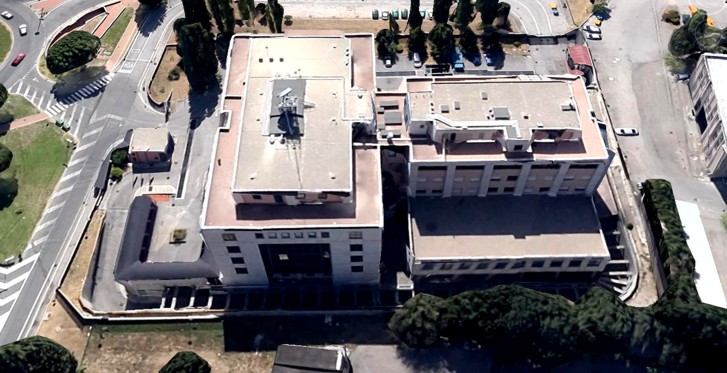
Perugia’s central police station where Sollecito made the statement posted here
The ever-expanding Wiki can of course be found here.
A post follows soon with guidance to the numerous new documents it contains. This was an extremely well documented case with discussions carefully recorded and decisions explained every step of the way.
We have frequently noted for example that RS and AK were provided with an extraordinary total of SIX opportunities in 2007 and 2008 to head off a trial and to be released.
Each opportunity is very well documented (Matteini hearings, Ricciarelli hearings, Mignini hearings, Supreme Court rulings, and the two Micheli rulings) and the transcripts and reports make very clear why RS and AK failed each time.
Not one of those transcripts or rulings has been “explained” or rebutted by the RS and AK apologists. It is very clear now that their falsifying efforts are being left way back there in the dust.
Document after document after document proving the case is going live in English for which they have been able to create no response. For example, the “brutal” Knox “interrogation” on 6 November is absolutely vital to their body of claims.
But document after document has shown that to be simply a huge hoax. Dumb silence is the only response.
This new translation of Sollecito’s statement of 6 November 2007 in the central police station, complete for the first time, has just gone live on the Wiki here. As always, we sure appreciate the translation help.
Note: Many of the claims here were proved wrong by phone and computer records and those dropping Knox in the soup contradict claims by Knox.
Sollecito never agreed to testify or be cross-examined on this or many other statements . Smart move, from his point of view. At the same time from 20007 to 2016 Sollecito NEVER testified that Knox was simply at his home all of the 5 November 2007 night.
Perugia Police Headquarters
Flying Squad
General Affairs Area.SUBJECT: Witness statement of person informed of the facts given by SOLLECITO Raffaele, already identified.
On November 5th 2007 at 22:40 in the offices of the Flying Squad of the Perugia Police Headquarters. Before the undersigned of the Criminal Investigation Dept. Deputy Commissioner MONICA NAPOLEONI, Chief Inspector Antonio FACCHINI Vice Superintendent of Police Daniele MOSCATELLI, Assistant Chief Ettore FUOCO is present the above-mentioned who, to supplement the declarations made [November] in these Offices, in regards to the facts being investigated, declares as follows: [*A.D.R. = Question Answer = QA]
QA I have known Amanda for about two weeks. From the night that I met her she started sleeping at my house. On November 1st, I woke up at around 11, I had breakfast with Amanda then she went out and I went back to bed. Then around 13:00-14:00 I met her at her house again. Meredith was there too. Amanda and I had lunch while Meredith did not have lunch with us.
QA Around 16:00 Meredith left in a hurry without saying where she was going. Amanda and I stayed home until about 17:30-18:00.
QA We left the house, we went into town, but I don’t remember what we did.
QA We stayed there from 18:00 until 20:30/21:00. At 21:00 I went home alone because Amanda told me that she was going to go to the pub Le Chic because she wanted to meet some friends.QA At this point we said goodbye and I headed home while she headed towards the center.
QA I went home alone, sat at the computer and rolled myself a spliff. Surely I had dinner but I don’t remember what I ate. Around 23:00 my father called at my home number 075.9660789. During that time I remember Amanda had not come back yet.
QA I browsed at my computer for another two hours after my father’s phone call and only stopped when Amanda came back presumably around 1:00.
QA I don’t remember how she was dressed and if she was dressed the same way as when we said goodbye before dinner.
QA I don’t remember if we had sex that night.
QA The following morning around 10:00 we woke up, she told me she wanted to go home and take a shower and change clothes.
QA In fact at around 10:30 she went out and I went back to sleep. When she went out that morning to go to her house, Amanda also took an empty bag telling me she needed it for dirty clothes.
QA At around 11:30 she came back home and I remember she had changed clothes; she had her usual bag with her.
QA I don’t know the contents of her bag.
QA I remember we immediately went to the kitchen, we sat down and talked for a while, perhaps we had breakfast. In that circumstance Amanda told me that when she got to her house she found the entrance door wide open and some traces of blood in the small bathroom and she asked me if it sounded strange. I answered that it did and I also advised her to call her housemates. She said she had called Filomena but that Meredith was not answering.
QA At around 12:00 we left the house; passing through Corso Garibaldi we arrived in Piazza Grimana, then we went through the Sant’ Antonio parking lot and reached Amanda’s house. To walk there it took us about 10 minutes.
QA As soon as we got there she opened the door with her keys, I went in and I noticed that Filomena’s door was wide open with some glass on the floor and her room was in a complete mess. The door to Amanda’s room was open and I noticed that it was tidy. Then I went towards Meredith’s door and saw that it was locked. Before this I looked to see if it was true what Amanda had told me about the blood in the bathroom and I noticed drops of blood in the sink, while on the mat there was something strange - a mixture of blood and water, while the rest of the bathroom was clean.
QA I went to the kitchen and saw that everything was in order, then went around the rest of the house, I went to Laura’s room and noticed it was tidy. In that moment Amanda went inside the big bathroom, next to the kitchen and came out frightened and hugging me tight telling me that earlier, when she took the shower, she had seen feces inside the toilet, while now the toilet was clean. QA I just took a rapid glance at the bathroom trusting what Amanda had told me.
QA At that point I was asking myself what could have happened and I went out to find Meredith’s window to see if I could climb to it. I went outside with Amanda and she tried to climb to it, I immediately stopped her telling her to not do it because it was dangerous. I then told Amanda that the best solution was to break down the door, I tried to kick it and shoulder it open but I didn’t manage to open it. Then I called my sister on her cellphone and asked her what I should do since she is a Carabinieri lieutenant. My sister told me to call the Carabinieri (112, the Italian emergency number), which I did, but in the meantime the Postal Police showed up.
QA In my previous statement I told a load of rubbish because Amanda had convinced me of her version of the facts and I didn’t think about the inconsistencies. I heard the first statements that she made to the Postal Police who intervened at the place.
QA She always carried a big bag that she also had the night of November 1st.
The investigating officials acknowledge that the deposition ends at 3:30 (AM) of November 6th 2007.
Sunday, February 15, 2015
Sollecito v Italy & Guede: My Subtitled YouTubes Of Rudy Guede’s Interview with Leosini
Posted by Eric Paroissien
Saturday, November 29, 2014
The PMF/TJMK Master Evidence List: First Of Our Projects To Make The Final Picture Whole
Posted by Our Main Posters
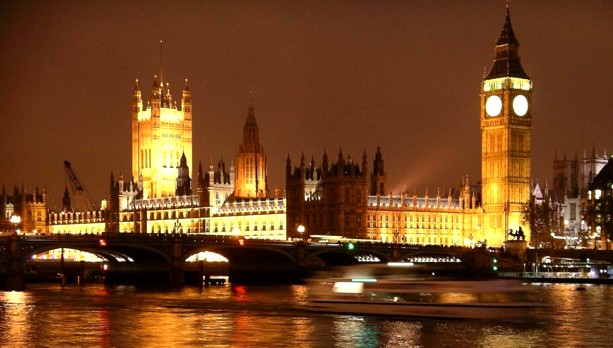
High-achiever Meredith Kercher was born less than one mile south of this famous London landmark
Building An Evidence Mountain
There are really three pictures, not just the one, still to be fully made whole.
- That of Meredith. We believe a family site will soon add to the fine book published by Meredith’s dad.
- That of all of the evidence the court acquired in 2009, which is the sole picture the Italian citizenry takes seriously.
- That of the misleading campaign by the Knox and Sollecito PR shills, leaving some in the UK and US misled.
The Master Evidence List is a key part of the second picture and there are several other media-friendly pages still to come.
Please click here for more
Monday, September 15, 2014
Analysis #1 Of Testimony Of Marco Chiacchiera, Director, Organized Crime Section, Flying Squad
Posted by Cardiol MD
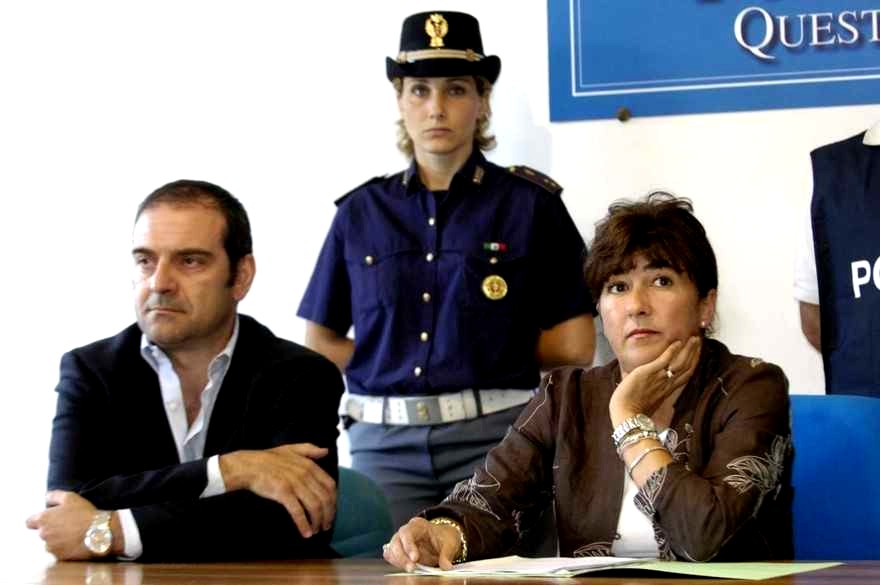
Dr Chiacchiera with Dr Comodi explaining reason for charges in another case
Overview Of This Series
Yet another vital translation which will be posted in the trial testimony areaof McCall’s great Wiki. This again is translated by the ever-dedicated main posterr ZiaK.
Although I graduated as a medical doctor I also graduated as a lawyer, and was often in courtrooms. For this post and the rest of the Chiacchiera series I am wearing my lawyer’s hat to point out what strikes me in Prosecutor Comodi’s questions, Marco Chiacchiera’s testimony, and the cross-examinations by defense lawyers.
Prior Preparations And Procedures
Under the Italian Code, before the beginning of the trial phase in Italy, the parties file a brief, detailing all evidence they want to present ““ the parties have to indicate by name every witness and precisely what these will be asked. The aims include creation of a Record of Admissible Facts.
Also under the Italian Code, both the defendant and the prosecutor can cross-examine each other’s witnesses. The Judge may choose not to admit any testimony that appears patently superfluous, reject irrelevant or improper or irregular questions ““ such as leading questions, and Inadmissible Hearsay ““ and also ask questions to the witnesses and experts.
Ground Covered In Dr Chiacchiera’s Testimony
- (1) He found Knox and Sollecito uncooperative when he asked them questions.
(2) Saw evidence contradicting any lone burglar theory and indicating that the “break-In” to Romanelli’s room was faked.
(3) Phone records and the police investigation into the accused phone activity the night of the murder.
(4) Discovery of pornographic magazines at Sollecito’s house.
(5) Details of how the large knife, Exhibit 36, was collected from Sollecito’s and the evidence that it is the murder knife.
My Assessment Of This Court Exchange
It is immediately obvious to me that this witness is a skilled witness; as such, and given his deep hands-on involvement in the immediate investigation this witness’s testimony is credible. My assessment therefore is that this was a very good and unflinching witness and that Dr Comodi shows no signs of leading the witness or seeking other than a truthful record.
I have seen prosecutors examine witnesses differently but dont believe the resultant record would have been superior. This would have stood up well in any American court.
(GCM=Giancarlo Massei; MC=Manuela Comodi; MaCh=Marco Chiacchiera; GB=Giulia Bongiorno; DD=Donatella Donati; CP=Carlo Pacelli; LG=Luciano Ghirga; CDV=Carlo Dalla Vedova; FM=Francesco Maresca)
Public Prosecutor Comodi [MC]
MC: Dr Chiacchiera, you carried out your duties where, when, at what moment of the events?
MaCh: I was and am the director of the Organized Crime Section of the Flying Squad and I am the vice-director of the Flying Squad. The Organized Crime Section is a branch of the Flying Squad that deals with “¦ the term, I think that in this place [i.e. the court] it is enough to say that it deals with organized crime. However, I am also the vice-director of the Flying Squad, for which [reason] I deal with, in the case of need, everything that is necessary [for] the various aspects.
{Witness supplies 5 items of relevant information that Examiner should elicit at beginning of examination.}
MC: Can you tell the Court how you became aware of events, who called you, when you became involved?
{Examiner asks another triple-question}
MaCh: Yes.
{Witness simply answers question as worded by Examiner}
MC: For now, start to tell us, then maybe I will intervene [NdT: i.e. interrupt with further questions] if necessary.
{Examiner, asking no Q, instructs witness, suggesting provisional forbearance if witness does not make interruptions necessary.}
MaCh: On the fateful day, at around 12:33, I had gone to the cemetery with my mother. The operations room called me immediately after the discovery of the body.
{Witness begins appropriate narrative response, but Examiner interrupts}
MC: So the 113? [NdT: 113 is the Italian State Police emergency number]
{Examiner interrupts witness with a Q, suggesting witness's receipt of call from an emergency number, but suggests wrong source-number}
MaCh: 110. The operations room of the Questura called me, and informed me of the happenings in an initially obviously very summarized manner. They said to me that there was a suspicious death, a young woman who lived in via della Pergola. I rushed to the place directly in my mother’s car. I didn’t stop by at the Questura, I didn’t go to get the service [i.e. police] car. I got myself taken to via della Pergola. We took about 15 minutes from the cemetery to there, ten fifteen minutes. In the meantime, I phoned the deputy Commissioner Napoleoni, in the temporary absence of the director, Dr Profazio, who arrived later, who was “¦ he was enjoying a period of leave, and with deputy Commissioner Napoleoni we arrived almost at the same time. We arrived almost simultaneously at the premises. Forensics, too, arrived almost at the same time at the premises.
{Witness supplies correct source-number and resumes interrupted narrative response}
MC: The Perugia Forensics?
{Examiner questions witness's correction, as if to verify and to ensure accuracy of court's record}
MaCh: The Perugia Forensics, I highlight, yes.
{Witness emphatically agrees with Examiner's question}
MC:”‹[They were] alerted by you, or ...?
{Examiner pauses mid-Q, inviting witness to guess complete Q, or is interrupted}
MaCh:”‹Alerted by the operations room, and also alerted by me.
,
{Witness responds to invitation, or interrupts with A to assumed complete Q}
MC:”‹So you arrive, and who do you find?
{Examiner's 1st simple Q.}
MaCh: “‹I found there ... there was already deputy Commissioner Napoleoni, there were also a few of Meredith’s co-tenants. There was Amanda Knox, there was Raffaele Sollecito. There were two young men who were, I believe, the friend of the boyfriend of one of the co-tenants. In short, there were a few people who had already been inside the house. There was the Postal Police.
{Witness answers Q in reasonable detail}
MC:”‹In the person of”¦?
{Examiner seeks more detail re specific Postal Police Personnel}
MaCh: “‹Battistelli and another of Battistelli’s colleagues. Inspector Battistelli, with whom there was immediately a discussion in order to understand what were the reasons for his intervention there, because it is not normal to find the Postal [police] in a crime of this sort. And he explained to me immediately what was the reason for his intervention. The origin of the, shall we way of his intervention, was due to the discovery of a pair of cellphones in a period of time, I believe, of an hour, [or] two, I don’t recall clearly, that were one in the name of one of Meredith’s co-tenants and one in the name of, later it [sic] “¦ I mean the SIM [card], obviously, the cellphones’ SIMs, the cards, they were in the name of a co-tenant and the other in Meredith’s [name]. The co-tenant, however, then told us, we then ascertained that both of the cellphones in fact were used by Meredith. And already that was, how shall we say, a first detail on which we began to reflect because, in fact, that was an element than in some way made us [become] immediately occupied/involved from an investigative point of view.
{Witness responds to Q and includes relevant amplifying narrative, anticipating probable future Qs re cellphones}
MC: “‹So, excuse me, also if the Court already, shall we say, knows this, because others have reported it, on this point however, where were the cellphones found?
{Examiner seems to interrupt with simple Q to clarify specific relevant fact not yet reached}
MaCh:”‹Inside the garden of a villa that is in via Sperandio.
{Witness responds appropriately}
MC:”‹In via Sperandio.
{Probably a Q, but implicitly inviting more specificity}
MaCh: “‹A villa that ... I am Perugian, [and] honestly, I didn’t even know there was a villa there. I’m Perugian, and I swear that I would have sworn [sic] that behind there was a wood.
{Witness flounders, seems unable to be more specific}
MC:”‹A field
{Probably a Q, but implicitly inviting more specificity}
MaCh: “‹It [was] the first time that I went in behind there. Instead, I see a marvelous old mansion with an enormous garden that gives ... that is almost adjacent to the street ““ the street that leads towards Ponte Rio. Anyone from Perugia understands me maybe.
{Witness seems to be in informal conversational mode}
MC: “‹From the structure of the fencing/enclosure, could you tell, shall we say, whether it was possible to throw these cellphones from the street, or whether it was necessary to enter the garden itself?
{Examiner engages witness, and asks Q to clarify how cellphones got into that garden}
MaCh: “‹Yes, obviously, we checked that. In fact, immediately, in short, the detail that seemed, how shall we say, of great investigative interest was that [very point], besides other details that I will go [into] a bit [sic], so to speak, also to give the impression of what the immediate impact was that we saw in the moment when we found ourselves in a situation of this type. So, deputy Napoleoni immediately entered inside the house in order to check it for herself. I did it [entered] shortly afterwards, also because [as] you will imagine that in that moment whoever was there had to notify all those who [sic], amongst whom Dr Mignini who was the Public Prosecutor on duty, and immediately give orders so that the correct checks are carried out. Because it was not just a crime scene that had to be analysed immediately: there also had to be, how shall we say, correlated with the information that we had got from via Sperandio ““ because the entry of the Postal [police in the case] originated with via Sperandio. And so we immediately asked ourselves: “Ah, what are these cellphones belonging to poor Meredith doing inside the garden of a villa?” And then And then immediately after, we asked ourselves, obviously, what might be the profile of the possible, or probable, murderer, and we discussed/talked about the crime scene. The crime scene immediately seemed fairly strange to us, if you wish [NdT: literally “if we wish” in Italian, but meaning the same as “shall we say”, “if you wish”, “so to speak” etc.]
{Witness responds to Q with detailed narrative}
MC:”‹Why?
{Examiner asks ambiguous Q, probably wrt crime scene seeming "fairly strange "}
MaCh:”‹Because the door did not show”¦ the entry door to the villa did not show signs of break-in. The we checked “¦
{Witness seems to decipher ambiguity correctly, begins narrative response, but is interrupted by Examiner}
MC:”‹We are not talking about the villa on via Sperandio obviously?
{Examiner interrupts with Q, apparently not comprehending Witness's narratives}
MaCh: “‹For the love of god! It was called a “villa” “¦ (overlap of voices), let’s say the house, of the house on via della Pergola there was no forcing/break-in. We found a forcing on the window. The window is this one, on the side of the house. I don’t know if you’ve seen the house? Anyhow, it is this one on the side of the house that can be seen immediately when you come down the slope from the gate. Logically reconstructing the thing, a hypothetical prowler [NdT: literally “ill-intentioned person”] who entered the house, breaking the glass with a rock - because inside the room, which was Romanelli’s room, which was the, shall we say, hypothetical arena of the entry, was completely in utter chaos. For that reason, what should we have hypothesized? That the hypothetical prowler took a rock, managed to throw the rock; the shutters, the external ones, the external shutters were not “¦
{Witness is exasperated at Examiner's apparent incomprehension, is repeating his previous testimony, but is interrupted by Examiner}
MC:”‹The dark-green wooden ones?
{Examiner interrupts with Leading Q re colour of external shutters. Now begins a confused and confusing colloquy. The arrangement of Filomena Romanelli's window, with Outside, and Inside Shutters, the Broken-Glass-Frame in-between, and the glass-splinters on the window-sill is complicated and needs a picture-exhibit that the witness can refer-to; this is apparently not provided, leading to the confusions}
MaCh:”‹The dark-green wooden ones were half shut, for which reason [he] must have had an aim like “Pecos Bill” [NdT: a cartoon Wild West cowboy], takes aim and throws that rock, smashes the window. After, he climbs up and does a turn on the little slope, and has to clamber up towards the window on the smooth surface, it seems to me, that from the ground up to the window there are two and a half metres-three [metres]. And then would have said: “bah, in short” [sic]. Yeah, well, the thing seemed to us…. in short, the first hypothesis that the investigator normally does, finds a level of unlikelihood of this kind of happening. After which, we looked at the house and we saw that an entry of a potential prowler [ill-intentioned person], still reasoning on the hypothesis”¦
{Witness amplifies narrative response but is interrupted by Examiner}
MC:”‹Of theft.
{Examiner inappropriately interrupts, incorrectly guessing what witness was about to say}
MaCh: “‹Of theft ending badly. Of theft that then degenerates because the burglar in some way thinks that he will find no-one in the house and instead finds a person, and then it degenerates “¦ We saw that there were easier means of entry, without wishing to bore you, but behind the house there was the possibility of climbing in a much easier way, without being seen by people that might have passed in the road. Let’s remember that, in short, it was not very late; quite the contrary. Normally people passed there, for which reason, if [he] had done it, the thing would probably have been seen. That thing there, as an hypothesis, we didn’t immediately discount it, that’s clear, because it’s a good rule to never discount any hypothesis. But we immediately considered that it was not a priority.
{Witness corrects Examiner's wrong guess, amplifies and seems to end narrative response}
MC:”‹Dr Chiacchiera, I interrupt you. (The witness is shown an exhibit.)
{Examiner, seems to acknowledge her habit of interruptions without actually interrupting, while introducing an unspecified exhibit. This introduction seems very informal, because Exhibits are normally identified by an assigned title.}
MaCh:”‹Ah! I didn’t remember it as being so big.
{Witness recognizes unspecified exhibit}
MC:”‹Precisely! You saw it? This is the rock that ...
{Examiner engages witness, stating it is "the rock".}
MaCh:”‹Yes, but it has been some time I have not, how shall we say, yes, I saw it. Absolutely.
However, it’s big, it’s huge.
{Witness engages Examiner, commenting on how large the rock exhibit is}
MC:”‹Do you consider that it could be this?
{Examiner ambiguously (what are "it" & "this "?) asks witness's opinion}
MaCh:”‹I believe so.
{Witness seems to overlook ambiguity of Q with vague A)
MC:"‹I try "¦
{Examiner begins to speak but is interrupted}
Judge Massei [GCM]:”‹How?
{Court interrupts as if to ask Q how Examiner 'tries'}
MC:”‹It is this. Yes, it is this one that was collected, yes, that was found.
{Witness seems to confirm that exhibited rock is the rock found in Filomena's room}
GCM:”‹So the rock is shown. [NdT: an “aside” for the court records?]
{Court formally announces admission of rock-exhibit, seemingly trying to reduce confusion caused by informal dialogue}
MaCh:”‹Inside the room where we then found the rock…
??:”‹But what was the question about the rock?
{Witness amplifies that rock had been found in a room, but enquires re rock Q, exposing confusion caused by informal dialogue}
GCM:”‹If this was the rock. And the witness said ...
{Court begins explanation to confused witness}
MaCh:”‹I said yes. Yes.
{Witness interrupts Court - confusion reigns}
GCM:”‹You saw it? You saw the rock?
{Court asks witness 2 Qs, trying to clarify that 'it' refers to 'the rock' that witness saw.}
MaCh:”‹Yes.
{Witness confirms that witness had previously seen the rock introduced into court as an unlisted exhibit.}
GCM:”‹When you saw it, where was it?
{Court proceeds to clarify confusion re where the rock was when witness originally saw the rock}
MaCh:”‹The rock [was] in the room of Romanelli.
{Witness specifically testifies, for witness's first time, that when witness originally saw the rock, the rock was in Filomena Romanelli's room}
GCM:”‹How far from the window? Can you say?
{Court continues to seek clarification using double-Q.}
MaCh: “‹A few centimetres [NdT: “un palmo” = “a hand’s width”] from the window sill, under the window, from the wall where the window is.
{Witness testifies clearly in answer to Court's 1st Q of above double-Q.}
GCM:”‹So from the internal perimeter wall, from where the window gives onto it, a “hand’s breadth”. So 20 centimetres…
{Court apparently begins to seek verification of witness's testimony, but is interrupted}
MaCh:”‹Mr President ....
{Witness begins to Interrupt Court}
GCM:”‹... away from it approximately.
{Court finishes his interrupted statement}
MaCh:”‹Yes.
{Witness agrees with Court's completed statement}
GCM:”‹And this is the rock. You remember it.
{Court states his understanding in form of Qs.}
MaCh:”‹Yes, yes, yes, yes. That is the rock.
{Witness impatiently agrees with Court's understanding}
MC:”‹At least as far as size and colour [are concerned], it corresponds thus to the one that was collected [as evidence].
{Examiner makes statements in form of Q, seeking verification of resemblance of exhibit-rock to original rock}
MaCh:”‹At least as far as size and colour [are concerned], it absolutely corresponds. If it was collected, I think that ...
{Witness begins narrative agreement with statements of Examiner, but is apparently interrupted by Examiner}
MC: “‹Very well. WITNESS [sic? Should be MaCh?] and Romanelli’s room was a complete shambles. The clothes were on the floor, the glass was strangely on top of the clothes, the [glass] shards were strangely on top of the “¦ on the windowsill, let’s put it that way.
{Apparent Transcriptional confusion attributing to interrupted witness narrative the interrupting .statement of Examiner}
MC:”‹The outside one.
{Examiner seems to amplify statement of Examiner wrt which window-shutter witness had been referring-to}
MaCh: “‹The outside one, precisely. The one that is between the shutters and the shutters [sic. NdT: “imposte” in Italian, but this can also mean shutters, or flap, as in the inner “scuri” shutters, or he may mean the window-frame itself, with the window-panes, given his following description], the green shutters and the shutters, the broken ones in short, where the glass is. The shutters ““ the wooden ones. The rock was a bit too close with regard to the wall if I [were to] throw it from least two metres. Unless it was lobbed [i.e. thrown in a high arc]. But in that case it’s rather unlikely that it would smash the glass. For that reason, I repeat, in the context of immediate likelihood, this one “¦
{Witness agrees with Examiner that he was referring to "The outside one", continuing with narrative of reasoning, but is interrupted by Examiner…}
MC:”‹Yes, it’s true. These are considerations. However they are considerations, shall we say, that refer [sic], because they are reasoning/lines of thought that are formed in the “immediacy” of the events [NdT: i.e. “in the immediate aftermath”. NOTE: throughout the text, a number of speakers use “immediatezza” (lit. “immediacy”) to convey a number of meanings, from “in the immediate aftermath”, or “in the immediate surroundings”, or “very soon after”, etc. I will translate them appropriately according to the context, without further explanation of the use of “immediatezza”], in order to proceed in one direction rather than another.
{Examiner, interrupting witness, apparently agreeing with witness's reasoning. While Examiner is apparently stating his own argumentative reservations re the possible evolution-in-time of witness's changing lines of reasoning, he is interrupted by Giulia Bongiorno, Sollecito defense lawyer:}
Giulia Bongiorno [GB]: “‹I never like to interrupt an examination [of a witness], however if one wanted, between the Public Prosecutor’s hypotheses, to do that [sic] of demonstrating that from a ballistic point of view it is not possible, then the ballistic expert should be called.
{GB interrupts Examiner to comment that Witness and Examiner are expressing opinions on Ballistics that require the testimony of a Ballistic Expert.}
MC:”‹But in fact, his considerations are not the considerations of an expert: they are the considerations of an investigator who made certain deductions in the immediacy of the events.
{Examiner argues that witness's testimony is that of an investigator's temporal train of thought.}
MaCh:”‹It happens to us too, at times, to reason/think rationally “¦
{Witness joins colloquy, amplifying Examiner's argument.}
GCM:”‹These reasonings/deductions, then determined your investigative activity in one direction rather than in an “¦?
{Court seems to invite further amplification by witness}
MaCh: “‹Yes, obviously, Mr President. I was trying to ... (overlap of voices) it is a premiss/basis to be able to then, how shall we say, reach ““ I won’t say conclusions ““ but in order to try to understand what our way of broaching the thing was, there and then. We had, I reassert, reasoned immediately also on via Sperandio. So the first thing, I may say, [was] the unlikelihood, or at any rate it was not the top priority hypothesis, the one of a prowler/ill-intentioned person entering. The open door without signs of break-in. But above all, a young woman who is [sic] probably killed in her own room, nude or almost nude, with a wound of that type, in a lake of blood, covered with a duvet. I repeat, the door was not smashed/wrecked, there’s a broken “¦ a window broken with a thrown rock, how can I say, it’s obvious that we immediately found this situation as “¦ (overlap of voices).
MaCh:”‹”¦ particular.
{Witness further amplifies narrative}
GCM:”‹You formed these considerations, and what did they lead you to?
{Court asks simple Q.}
MaCh: “‹That very probably the author or authors knew the person, or at any rate that the author or authors did not enter “¦ did not enter from the window-pane of that window.
{Witness responds with his conclusion that the authors of the faked break-in did not enter from the window-pane of that window.}
GCM: “‹Excuse me a moment, just to give some guidelines, but of the evaluations that the witness is expressing, obviously it’s not that they can be taken account of, however we will acquire them [for the trial files] in order to understand the investigation activities, the appropriateness of the investigations that were carried out, directed in one way or in another, there you go. However, maybe, “¦ there you go, yes, maybe if we can manage to keep with the bare essentials this will help everybody.
{Court proceedings seem to have been diverted into a free-for-all colloquy, with multiple participants chiming-in, and creating confusion. Court-President, GCM, now politely intervenes, apparently trying to restore order, ruling that the professional evaluations made by the witness, testified-to by the witness, should be admitted for the trial files. The appropriateness of the witness's evaluations can be dealt with separately and later.}
_________________________________________________
This segment of Chiacchiera’s Testimony re the Crime Scene, which he believed had been remodeled by the criminals to dupe Investigators into believing that there had been a burglary, committed by a single criminal, is paused here because it is so prolonged.
Analysis of Chiacchiera’s Testimony will continue in a future post.
Thursday, May 29, 2014
Ted “There Is No Evidence” Simon’s Tired Mantra Misinforms Americans And Provokes Italian Hard Line
Posted by Our Main Posters
No-evidence claim March 2013 contradicts tough-evidence claim Dec 2008
1. Is Ted Simon already fired?
Has Ted Simon been kicked off the Knox-Mellas team?
Ted Simon gets no mention on Knox’s website among the credits to her Italian legal and Seattle PR teams. He seems to serve zero useful purpose to anyone that we can see.
One could train a parrot to repeat “there is no evidence” for a smaller fee.
Ted Simon is certainly not helping Knox to get back to Planet Earth - in January Judge Nencini awarded her another year inside, and for continuing legal incautions Knox could certainly face more time.
As he seems utterly ineffective on all fronts, maybe it was high time that Ted Simon was gone.
2. If so five good reasons why
A year ago, he seemingly allowed (1) this false felony charge to be included in Knox’s book.
That malicious claim could result in more prison time for Knox, and maybe even open Ted Simon to a malpractice suit, for zero due diligence done on Knox’s book. Since then, Amanda Knox has shot herself in the foot four more times, at least, with no obvious legal restraint.
Knox charged ahead with (2) the insulting and inaccurate email to Judge Nencini, (3) the insulting and inaccurate appeal to the European Court of Human Rights, (3) the insulting and inaccurate first response to the Nencini Report, and the insulting and inaccurate website that Knox runs.
3. Seven more good reasons why
Our interest is for justice for Meredith and her family, for Italian justice to be seen in a fair light, and for an end to this protracted PR-driven dead-end fight, in which Ted Simon has had some hand.
So let us look at some other ways in which Ted Simon’s lazy mantra, a substitute for a convincing alternative scenario of the crime, gives, or at least gave, Amanda Knox false hopes and will ultimately let her down.
1. Take a look at this absurd claim by Ted Simon which millions of Americans now, large numbers of lawyers, and many TV hosts can laugh off as simply untrue.
“There was no hair, fiber, footprint, shoe print, handprint, palm print, fingerprint, sweat, saliva, DNA of Amanda Knox in the room where Meredith Kercher was killed,” attorney Theodore Simon told TODAY’s Savannah Guthrie. “That in and of itself tells you unassailably that she is innocent.” (CNN)
What exactly does that mean? Does Ted Simon even understand the scenario of the attack? This was a KNIFE attack, which does not usually see the exchange of a lot of DNA. There was the indisputable use of two knives in the attack - and Knox’s DNA is absolutely incontrovertibly on one.
Why does Ted Simon make no mention of that?
2. Meredith’s room was not fully swabbed for DNA because fingerprint dusting was the investigators’ (right) first choice. There were no fingerprints there - but there were none in Knox’s room either. Was she never there too? Knox’s lamp was found in Meredith room, with no prints. It would not have got there without help from her. There was a Knox-size shoeprint in the room. It would not have got there without help from her.
Why does Ted Simon make no mention of that?
3. Throughout the rest of the real crime-scene, which Ted Simon would really, really like Americans to forget includes a corridor, two bedrooms, and two bathrooms as well as Meredith’s room, there is stacks of unshaken forensic evidence against Knox. Indisputably a partial cleanup occurred because some footprints in several chains had been disappeared.
Why does Ted Simon make no mention of that?
4. There is, if anything, a surfeit of possible motives (not that there is a requirement for certainty there), and certainly there is a surfeit of alibis. Knox clearly framed Patrick. She was totally unprovoked by police, and yet even after three years actually served for felony framing, she continues to perpetrate the great hoax that she was.
Why does Ted Simon make no mention of that?
5. Amanda Knox is ever more frantically claiming that Rudy Guede carried out the crime against Meredith alone, and yet there is zero question of that. Many myths spread about Guede are untrue.
Why does Ted Simon make no mention of that?
6. Raffaele Sollecito was absolutely incontrovertibly in the apartment during the attack - his own lawyers have failed to prove the print on the mat was not his. Absent Knox, it is inconceivable that Sollecito was there.
Why does Ted Simon make no mention of that?
7. Finally dozens of lawyers are saying that the extradition treaty with Italy is crystal clear. If due process to a conviction was followed - and the American Embassy in Rome monitored it and saw nothing wrong - Knox could be on a plane within weeks to pay for what was a very cruel crime.
Why does Ted Simon make no mention of that?
4. Free! New Ted Simon mantras
Due to sudden problems with Ted Simon’s gibberish machine, we are happy to step up and provide these for free.
There was no hair, fiber, footprint, shoe print, handprint, palm print, fingerprint, sweat, saliva, DNA of Rudy Guede in the bathroom where there was a bloody footprint of RS and DNA of Knox,” attorney Theodore Simon told TODAY’s Savannah Guthrie. “That in and of itself tells you unassailably that Guede did not do the crime alone.”
There was no hair, fiber, footprint, shoe print, handprint, palm print, fingerprint, sweat, saliva, DNA of Rudy Guede in Filomena’s room where the breakin was staged, though there was Knox’s DNA” attorney Theodore Simon told TODAY’s Savannah Guthrie. “That in and of itself tells you unassailably that Amanda Knox is framing him.”
There was no hair, fiber, footprint, shoe print, handprint, palm print, fingerprint, sweat, saliva, DNA of Amanda Knox in the bedroom where she slept,” attorney Theodore Simon told TODAY’s Savannah Guthrie. “That in and of itself tells you unassailably that Knox did not even live in the flat.”
Look for them soon, on your local TV.
Wednesday, April 16, 2014
The Incriminating Bathroom Evidence: Visual Analysis shows the Footprint IS Sollecito’s
Posted by Machiavelli
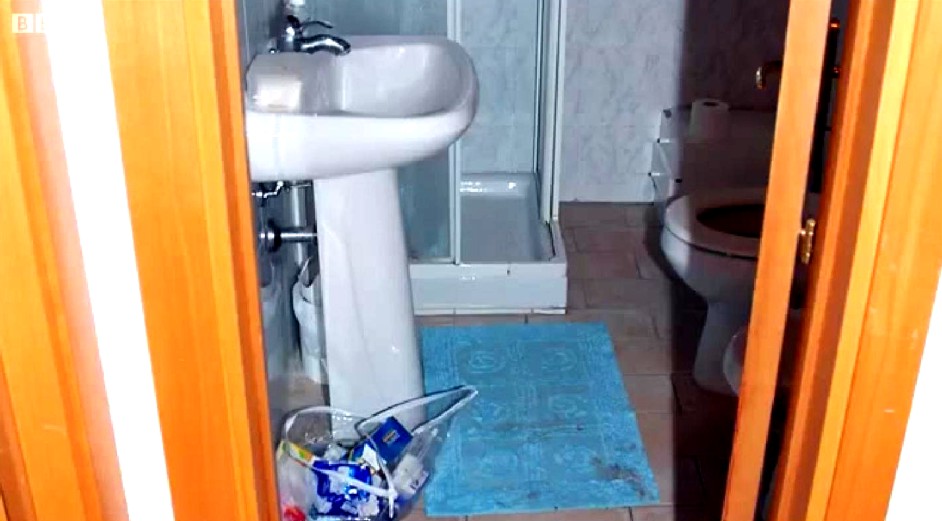
[Please click on each image for a larger and more high-resolution version]
The sheer depth and width of the hard evidence
The defenses really don’t want you to know this: in both width and depth, the full panoply of the evidence against Knox and Sollecito is absolutely overwhelming.
As we remarked in our post below there are far more and far stronger evidence points than UK and US courts normally require for conviction. But only the trial panel of judges observed anything like their full array.
The 2010 Massei Trial Report (which the Nencini Appeal court validated this past January) is a SUMMARY of what was presented to the judges in the courtroom. Those presentations in court were in turn something of a SUMMARY of the hard evidence buried in all the evidence files and the minds of witnesses.
Italian media SUMMARISED for Italians what was to be seen in the courtroom and to be read in the Massei Report. They were barely able to do even summaries for the 1/4 of all the trial hearings that were not open to the media or the public.
UK and US media for the most part didn’t even bother to provide comprehensive summaries (the very fine on-the-spot reportings of Andrea Vogt, Barbie Nadeau and Ann Wise were the main exceptions).
So in effect people in the UK and US attempting to follow the story didnt for the most part receive even a summary of a summary of a summary!
Not one US or UK newspaper or TV network translated the Micheli Report, or the vital Massei Report, or the Supreme Court appeal, or the Supreme Court outcome - only the (mostly professional) translators on PMF dot Org did all that translation.
This post is another example of how far down - beyond even Massei - it’s possible to drill into the evidence, and see it still hold up.
Some past posts on TJMK drilled down to similar depths, on the knives, on the DNA, on the mixed-blood traces, on the phone-events, on the motives and psychologies, and so on. All that evidence too all held up.
Visual analysis of the bathroom-mat footprint
This post mainly consists of high-resolution pictures and measurements. Presented like this, the pictures and measurements largely speak for themselves, and show the real strength of the bathroom-mat footprint evidence.
You will see that as SomeAlibi previously concluded using other methods, this footprint was quite undeniably Sollecito’s. It bears no similarity at all to Rudy Guede’s.
Please click on all images for larger versions in scalable PDF format
1 . [Below] the bathmat and the print, with measurement reference
2 . The bathmat print and the surrounding area
3 . The bathmat print (photo from Polizia Scientifica).
4 . The bathmat print, with vertical and horizontal sizes, from Rinaldi’s report
5. The bathmat print, photo with enhanced contrast.
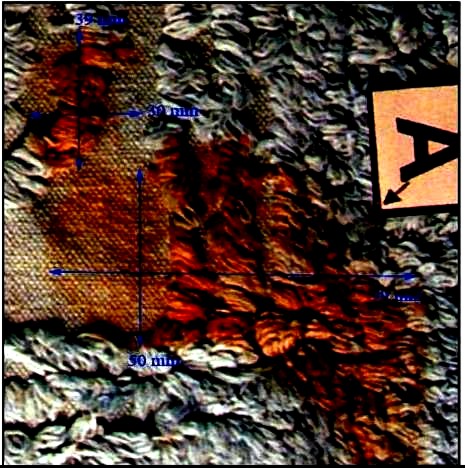
The photo above was modified by highly enhancing contrast.
6 . Enhanced contrast helps to spot some features
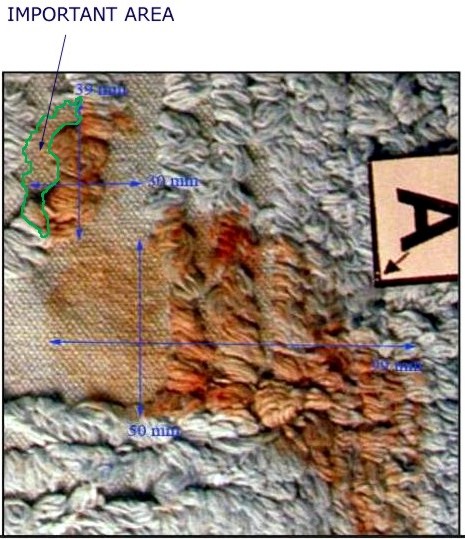
Contrast may help to highlight especially some parts of the print outline.
For example the area on the left labeled as “important area” in the picture (which was “forgotten” in the notorious photo elaborations disseminated by the ‘Friends of Amanda’ group), shows the actual left outline of the “˜big toe’ of the bathmat print.
The toe includes the area indicated in this picture (here the picture is shown again in its original colours).
7. The bathmat, with enhanced contrast
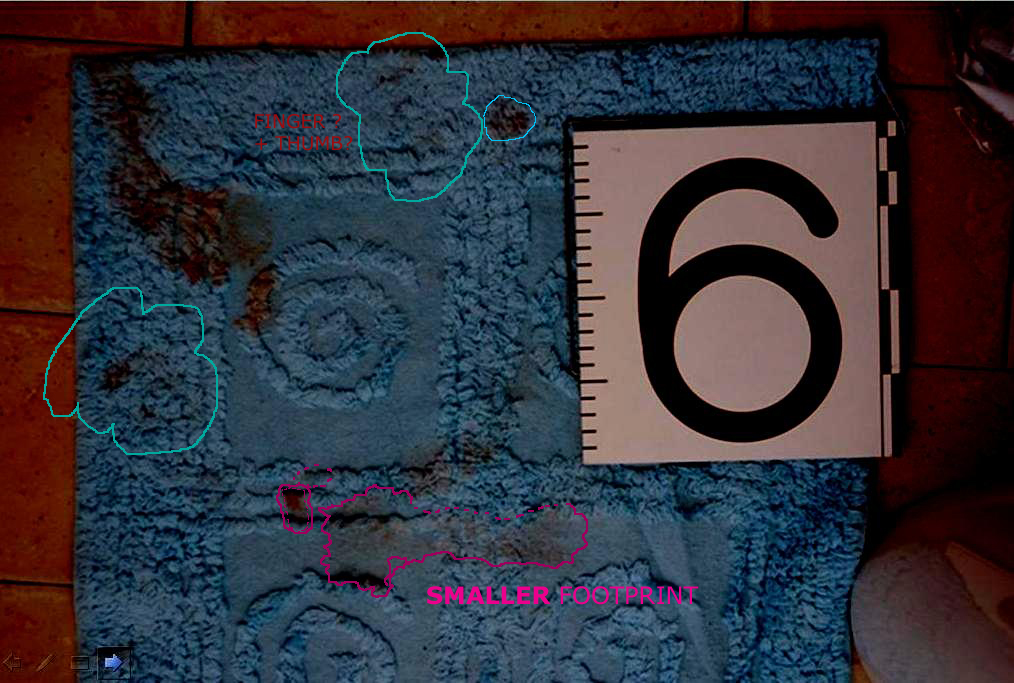
The contrasted image is showing the presence of other stains
There are other stains on the carpet (about another 10, factually situated in one half of the mat area), and also there shows a second diluted footprint (apparently from a foot of smaller size).
8. The selection of a set of red colour shades, outlined by an automatic outline generator
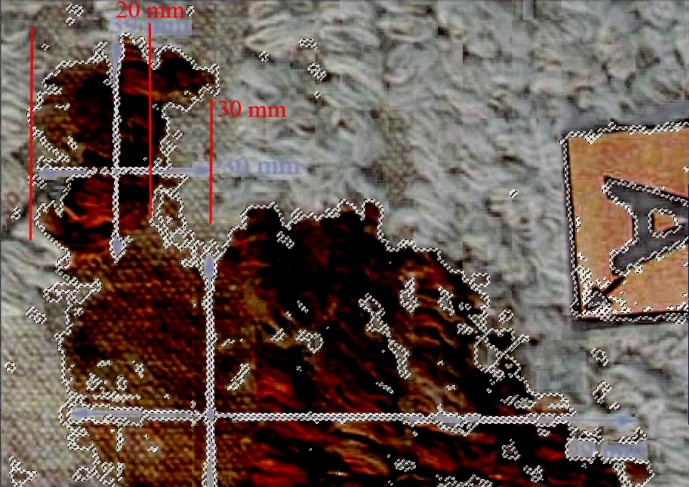
Shows the shape and the possible “˜outline’ of the stain
Reference measurements indicate the width of the “˜big toe’ in millimetres.
9 . A hand drawing of the outline (detail).
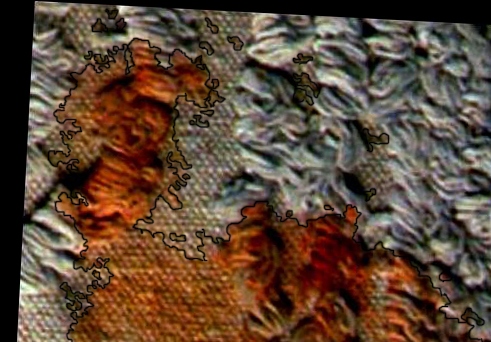
The photography above was modified
The modifications are: +28% contrast, -8% luminosity, + 20% colour saturation, from the original.
An outline has been drawn manually on the photoshop image, trying to be as faithful as possible to the actual stain.
You can notice that, apart from some minor “˜disputable’ very faint areas (such as the area between the toe and the metatarsus) there are only minimal differences between an automatically generated outline and a manually drawn one.
The shapes of the “˜big toe’ are extremely similar in both contours (images 8 and 9), in fact all meaningful features are basically identical.
We consider this manually drawn outline as good for comparison.
10 . The complete hand-drawn outline
11 . Minor detail: small dots separated from the main stain
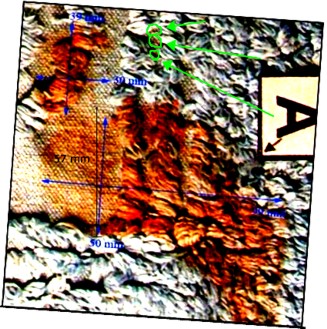
Observe the small red ‘dots’ in the picture above
Although we can’t draw any conclusion about their possible significance, we note the existence of these very small “˜spots’ of a faint red colour shade, separated from the big stain.
They are detected by the computer generated outline above, and that we also see as distinguishable with the naked eye thus we considered them in drawing manually the outline.
We don’t draw any conclusion about them; but because of their sensitive position (they may suggest a “˜small toe’ mark) we take note of them.
The green arrows in the picture point out their position (green circles).
12 . An image in electronically modified colours
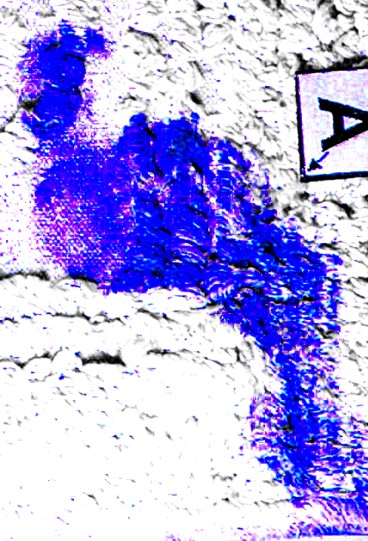
Distribution and intensity of the colouration
As a part of the preliminary study of the stain, we also produced this image above where the computer assigned an artificial colour to an array of shades of ‘red’, thus allowing to further isolate the stain from the background for further assessments about its shape.
This picture shows the distribution and intensity of the colouration. (note: the existence of some above mentioned tiny marks is recorded by this technique too)
13 . The bathmat has a spiral-shaped relief decoration
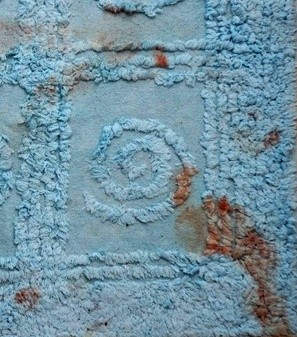
The footprint’s toe obviously balancing on top of the relief decoration.
We think the outline of the “˜toe’ mark of the bloody footprint is affected by the shape of the decoration, in particular the missing part of the toe on the right side, which is remarkably coincident with the margin of the decoration.
So that on that side there is a striking correspondence between the outline of the “˜negative area’ ““ the fabric surface around the spiral, which is lower ““ and the big toe’s outline
This indicates that the outline of that mark on that side was affected by the decoration margin, thus the print there has a “˜missing part’. So the “˜crooked’ bloody area in fact follows the margin of a larger toe.
Because of such coincidence, we can logically assume that the actual shape of the big toe mark appears to be part of a big toe, with larger surface which left its print only partly because part of its surface did not have contact with the fabric, in correspondence of the “˜negative area’.
14. The “negative area”
15. Mat decoration in relief and the toe mark
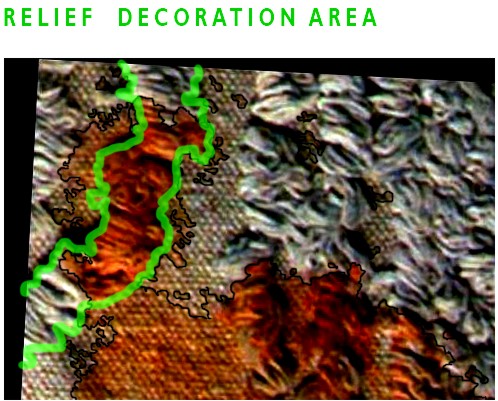
Observe above one single, unitary stain
The remarkable coincidence between the outlines of the decoration in relief and of the toe mark is shown in the picture above.
The rough contour of the print obtained through a smooth curve highlights the shape of the big toe.
Part of the relief decoration outline coincides with the toe mark outline, which shows, highlights and explains how all parts of the red toe mark, that you can see left of the relief decoration, they all belong to one single, unitary stain.
Thus we can deduce that the “missing” area on the right of the toe is determined by the decoration, and coincides with the negative area.
16. Picture (by Kermit) showing a rough shape of the stain
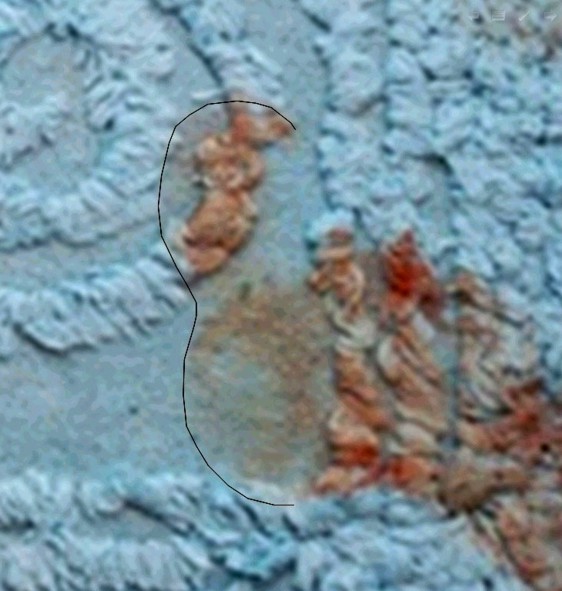
Observe shape, curvature and size
This drawing by Kermit above highlights the rough shape, curvature of left margin and overall size of the big toe.
17. Rudy Guede’s sample print
A copy of this picture together with one of Sollecito’s print at the same scale will be used for comparisons.
18 . Raffaele Sollecito’s sample print
A copy of this picture together with one of Guede’s print at the same scale will be used for comparisons.
19. Part of Rudy Guede’s sample print with Rinaldi’s reference measurements
20. Part of Sollecito’s sample print, with Rinaldi’s reference measurements:
21. Bringing all photographs down to the same scale
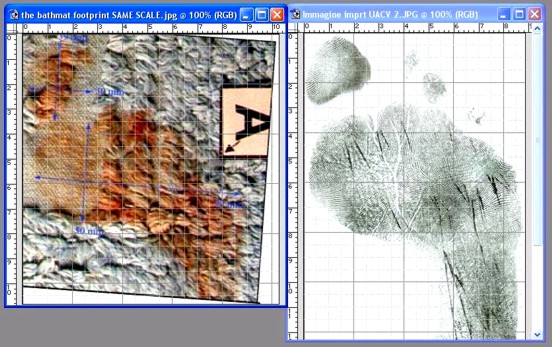
An accurate exercise of scaling was done
This was based on Rinaldi’s referenced pictures. Each one of the Rinaldi’s sample pictures has multiple measurements on several points of reference which allow a high precision determination of their scale and sizes, and thus comparison at the same scale.
In order to further increase scaling precision, the scale was calculated previously and separately for each comparative measurement in the three photos; this was done multiple times for each measurement and the average was picked in order to reduce error as for statistical measurement method.
The resulting final error in the scale is extremely small, far below a threshold of significance that could affect comparison (which was set arbitrarily at 1%, but it’s probably significantly higher, while the actual error is much lower).
In other words, the scale error that may affect your screen pictures will be definitely smaller than any possible perceivable (either significant or tolerated) difference that would be noticed or that may affect the attribution of the stain, when this is compared to the sample.
22. The hand drawn outline is shown again here
23 . The outline (matched scale) overlapped on Sollecito’s sample footprint
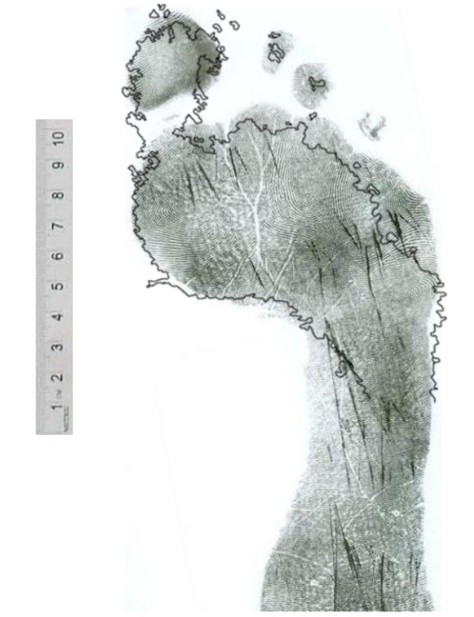
The array of compatibilities with Sollecito
The bathmat stain does not seem to have major incompatibilities with Sollecito’s print; it shows rather an array of compatibilities that can be perceived visually.
One interesting feature is the shape, size and position of a ‘big toe’, that appears as a remarkable coincidence; the toe also has a kind of cleft (see 28 below) on the curvature of its left margin. Another outstanding coincidence is the curvature of the plantar arch on the left.
24 . The same outline overlapped on Guede’s footprint
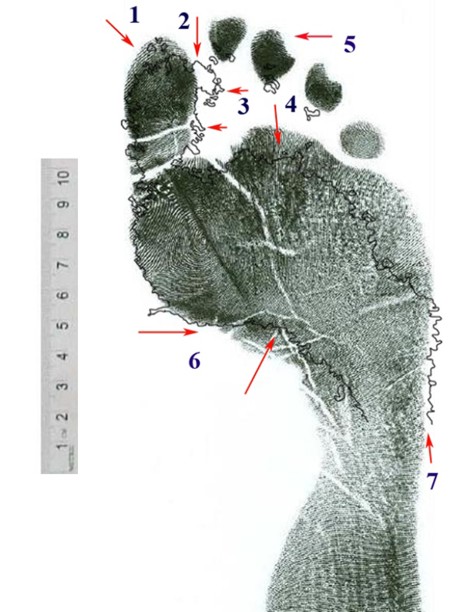
Compare with Guede’s - matched scale.
If you look at the overlapping of the stain outline (see pic 22.) with the sample of Guede’s print (see pics 17. 19.), you may notice 7 major differences, showing a failure of compatibility. Those differences are indicated by numbers (1-7) in the picture .
Each one indicates an area of major difference between the outline of the bathmat stain and the outline of Guede’s sample print. Those measurement differences are remarkably larger than those that can be detected on the overlapping with Sollecito’s sample print.
On the other hand, the compatibility between Sollecito’s print and some very peculiar aspects of the bathmat print (such as a 30mm wide and short toe) were absolutely remarkable.
The differences between the bathmat stain and Guede’s print are :
1) Toe mark of stain is significantly SHORTER than the big toe in Guede’s sample print (a difference of about 7 millimetres). Some people may want to attempt an objection, by suggesting that such a difference may be just a consequence of the position chosen for the overlapping, that maybe the bathmat print was just positioned too low in the picture, the problem may be solved by shifting it up about 7 millimeters so as to make the tip of the bathmat toe ‘coincide’ with the tip of Guede’s print toe.
However, such objection wouldn’t work; it’s a wrong argument. In fact the only possibly correct position for overlapping the bathmat stain outline is determined by the left curvature of the ball of feet and plantar arch (the area of the picture near number 6), which is by the way the most clearly outlined part of the bathmat stain. If you shift the bathmat stain upwards, the outline will miss the match with the curvature of the left margin of the ball of the feet. You will notice that the plantar arch in this area is already very incompatible with Guede’s plantar arch. It tends to become even more incompatible the more you shift the bathmat stain outline towards the toe.
The problem has no solution, since the more you shift the stain outline upwards (in the direction of the toe) in an attempt to make it look more ‘compatible’ with the length of Guede’s toe (or with an upper margin) the more it will become incompatible with the plantar arch. In order to limit the incompatibility of the plantar arch, and in order to keep an overlapping of at least the left margin of the ball of the feet, you need to place it as shown in the picture, this is the position of ‘maximum’ compatibility between the bathmat stain and Guede’s print. Conclusion: the bathmat toe is too short.
2) Toe mark of stain is TOO WIDE (30 mm). It is much wider (30 mm) than Guede’s toe. The number 2. indicates the protruding mark at the upper right, the mark which Giulia Bongiorno desperately insisted on calling a “second toe” mark. In fact, not only would the mark miss completely any hypothetical Guede’s ‘second toe’ in any possible position of the print; also you may notice (highlighted by pics 8. and 9.) how it is not a “mark” itself, but actually it just part of the same area which is entirely continuous in shape and coloration with the rest of the toe mark, and - the most remarkable feature - its right outline is coincident with the outline of the spiral-shaped relief decoration, so that you can reasonably conclude that it is determined by that (the missing area at the lower right of the ‘big toe’ is determined by the existence of the “negative area” of the bathmat decoration).
Conclusion: the bathmat stain has a wider toe mark, however one likes to call it (“big toe”, or “big toe + second toe”) that fails to match any possible part of Guede’s print. The bathmat print is clearly different and incompatible with Guede’s print. It simply cannot be overlapped to any part of Guede’s sample print. Such area is a very significant difference that points outright to incompatibility between the stain and Guede’s print.
3) The toe mark is larger also in the area located at the lower portion of the toe. The toe of the bathmat print in fact has a ‘right margin’ which actually has some additional small marks, small drops protruding towards the right, like droplets maybe produced by the wet cotton fibres of the part in relief which protrude towards the right. This tends to suggest the toe area of the stain may in fact be considered wider: the object that produced it was definitely wider than 22mm, in this area of the toe as well. So also a look at this area confirms that the bathmat stain is wider than 22-23 mm (more towards 30 mm) not just when measured at the upper corner (number 2.) but also at its “lower” parts; here, the small marks caused by the liquid suggest that a larger surface has squeezed liquid from some fabric threads leaving some trace also on the lower area.
4) Bigger incompatibility of Guede on the metatarsus front outline. This area is the front outline of metatarsus: the stain is almost 1cm shorter than Guede’s metatarsus. This happens when you chose the overlapping so as to make the left outline and plantar arch (6.) of metatarsus coincide, as in the picture. Sollecito’s sample print also shows some difference from the stain in this area (pic. 23.) but the difference between the stain and Sollecito’s print is significantly smaller than what you can see in Guede’s print.
5) There are NO SMALL TOES in the bathmat stain. Small toes are completely absent from the bathmat stain (while the tiny blood marks around the stain don’t coincide with their expected position if it was Guede’s print). Such lack of small toes is a peculiarity of the bathmat print. This is a remarkable difference from Guede’s print, and at the same time, a considerable analogy with Sollecito’s print. In fact one outstanding feature of Guede’s print is the evidence that Guede places a big load of weight on his small toes while instead Sollecito has a posture with a weight distribution with the contrary tendency, and obviously he almost does not touch the ground with his small toes.
Thus, Guede’s small toes are all very well pressed on the ground and thus, we can reasonably infer they are somehow naturally likely to get wet if he steps on any wet surface, and anyway they should get wet for sure if the foot is immersed in water or washed (the foot that left the bathmat print must have been immersed in bloody water). The murderer supposedly washed his foot then stepped on the bathmat. In order to attribute the print to Guede we should assume that Guede “forgot” to touch the carpet with his small toes (while instead he puts a lot of weight on them) or that he managed to not rinse them.
6) The outline of the stain has a PLANTAR ARCH that COINCIDES, by curvature and angle, with the plantar arch in Sollecito’s print, while instead it is very different from the plantar arch of Guede’s print.
7) The stain is larger than Guede’s print metatarsus as visible in the right area of the stain. The difference is rather significant, almost half a centimetre, that is bigger than the difference with Sollecito’s print which instead coincides for a trait. This difference cannot be “solved” in any way since, even if one wanted to claim that the scale is wrong and that the stain should be sized down, this would make the toe, already too short (as in 1.) become even shorter.
If instead the toe length is adjusted the metatarsus becomes even less compatible with Guede. We recall that Massei found that Guede’s feet had a print overall more slender than Sollecito’s.
25 . Other features:
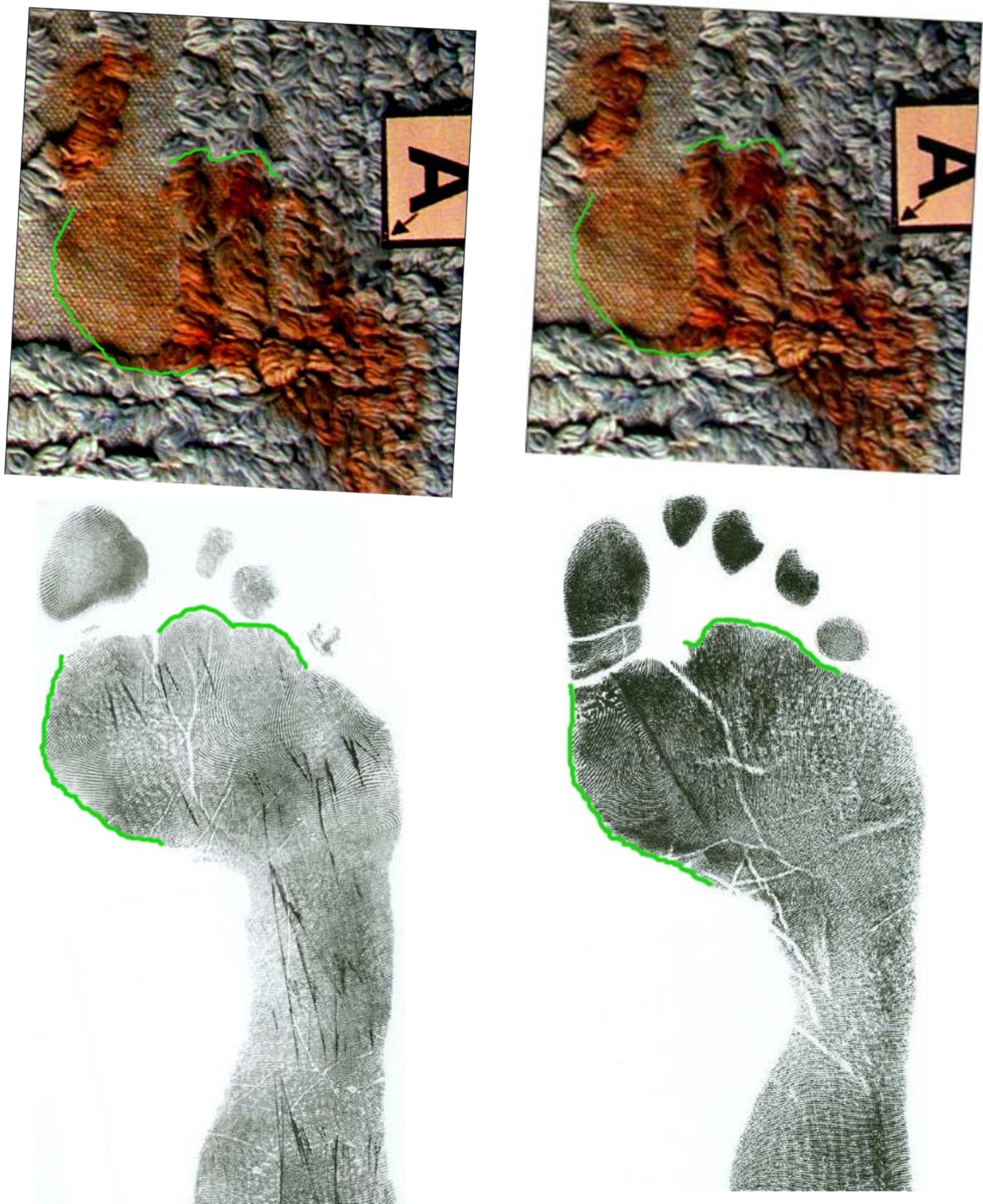
Curvatures of plantar arch are very different
The plantar arch curvature, highlighted in two different drawings (the second highlights also the upper outline “hunches”); the plantar arches in the two sample prints of Sollecito and Guede are shown below. The curvatures of plantar arch are very different.
26. The outline curvature generates different angles
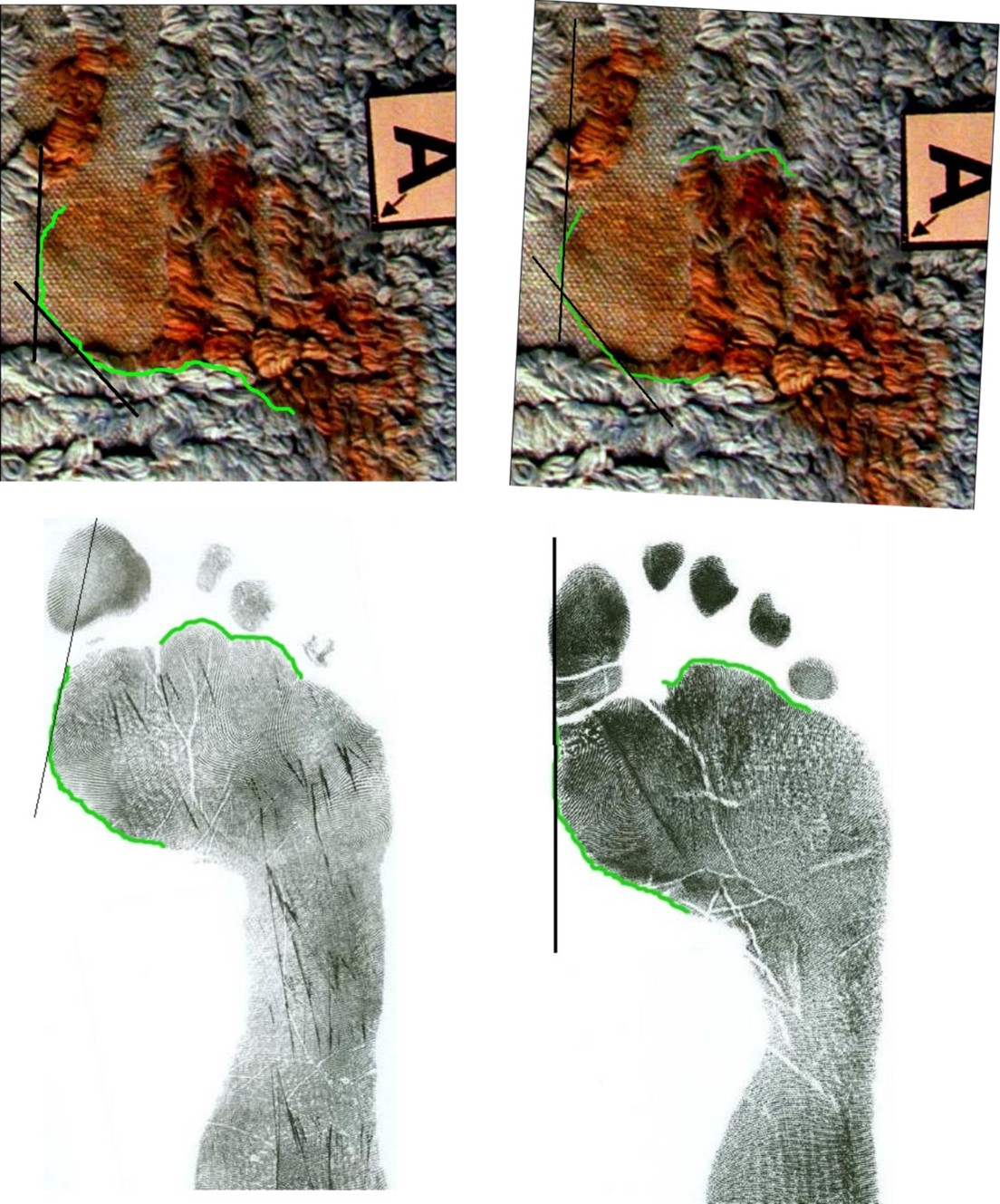
Sollecito’s and Guede’s plantar arch curvatures have very different angles. Also the left outline of metatarsus maintains a different curvature. Sollecito’s outline has an angle (see outline tangent) intersecting the toe (the metatarsus has a “bunion”); in Guede’s print there is basically no intersection, the outline and the toe form almost a straight line.
27 . Plantar arch curvature angle differs between Sollecito and Guede
If you consider the vertical axis of the sample footprint, and its orthogonal line, you may notice how the plantar arch curvatures of the two prints accomplish different angles: the two angles are VERY different, not just three or four degrees.
The (too) narrow angle of Sollecito’s plantar arch probably has a relation with the protruding outline and angle seen in pic 26., and seems related to a hallux valgus (which Guede does not have).
28 . The “cleft” on the left side of the stain
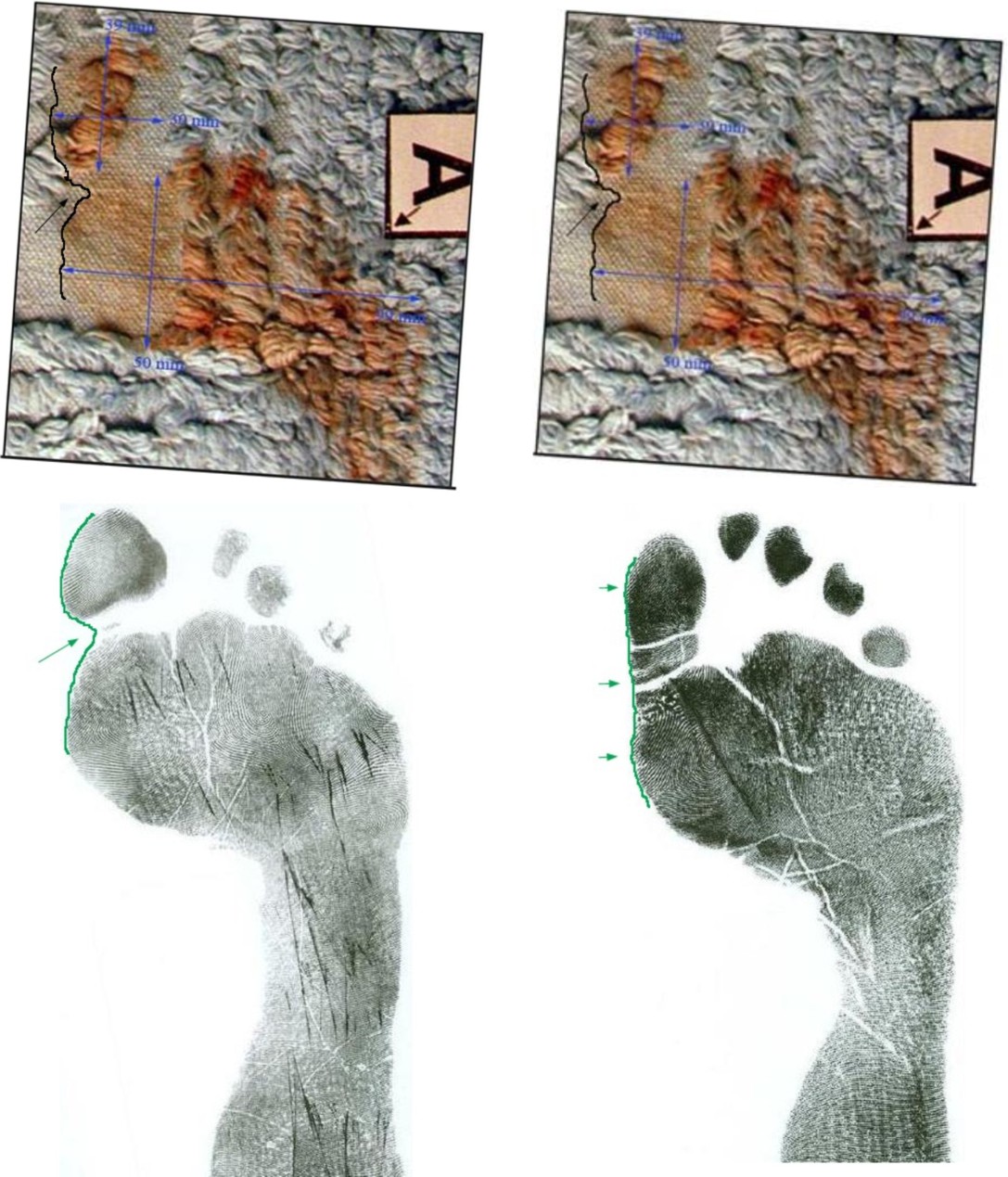
The “cleft” on the left side
This has a correspondence with one sample print, not so with the other.
29 . Table of metric comparison (by SomeAlibi)
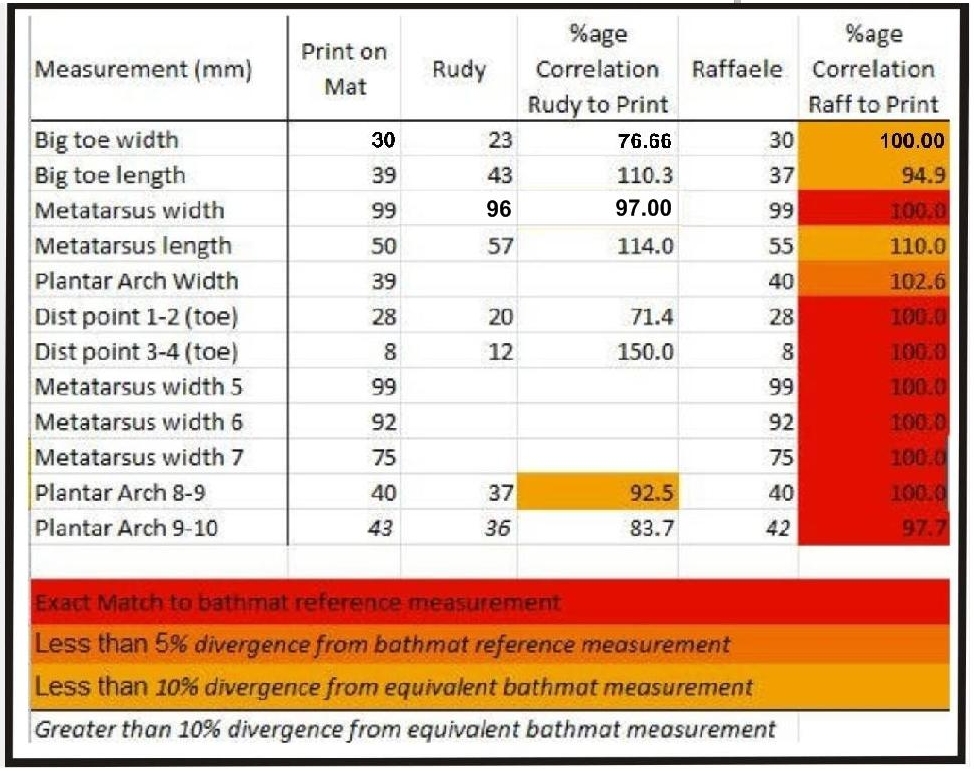
SomeAlibi’s post of a year ago
Comparison of measurements and analysis of correspondence degree of bathmat print, with both Guede’s and Sollecito’s sample prints.



